Leader–follower formation control of nonholonomic mobile robots with input constraints
- 格式:pdf
- 大小:728.41 KB
- 文档页数:7
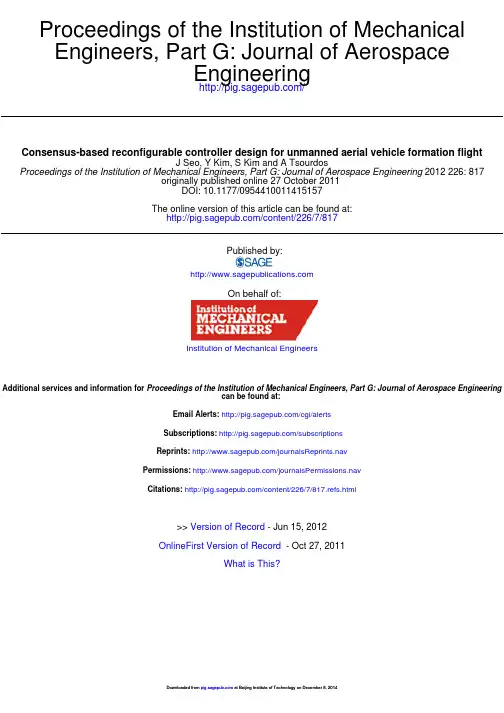
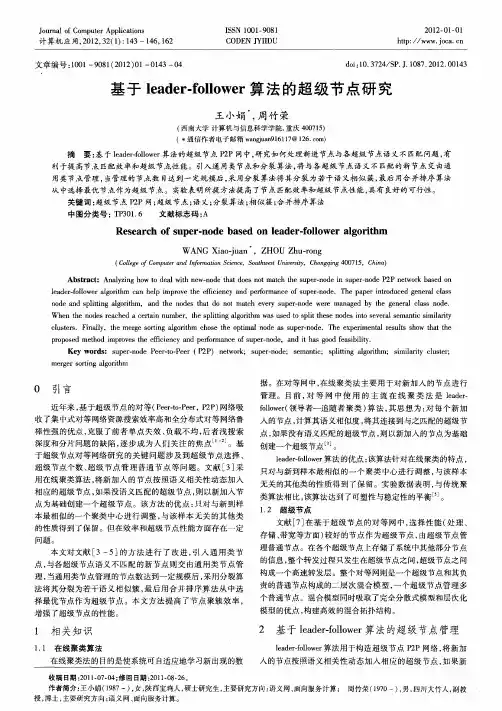

专利名称:Leader-follower power control发明人:Mark J. Miller,John H. O'Neill申请号:US11462811申请日:20060807公开号:US07580673B2公开日:20090825专利内容由知识产权出版社提供专利附图:摘要:In a satellite or other relayed communication system having a plurality of subscriber terminals that communicate through an elevated wireless relay (typically a satellite operating in bent pipe mode), a technique for subscriber terminal power control is provided whereby the power level is controlled via leader-follower operation relyingon sharing control factors determined at a single calibrated subscriber terminal transmitter (the leader terminal) to create traffic to be compared to the received traffic of the other subscriber terminals. The power level of the subscriber terminals is then adjusted based on the relationship of their received energy to the received energy of the leader terminal.申请人:Mark J. Miller,John H. O'Neill地址:Vista CA US,Carlsbad CA US国籍:US,US代理机构:Townsend and Townsend and Crew LLP更多信息请下载全文后查看。
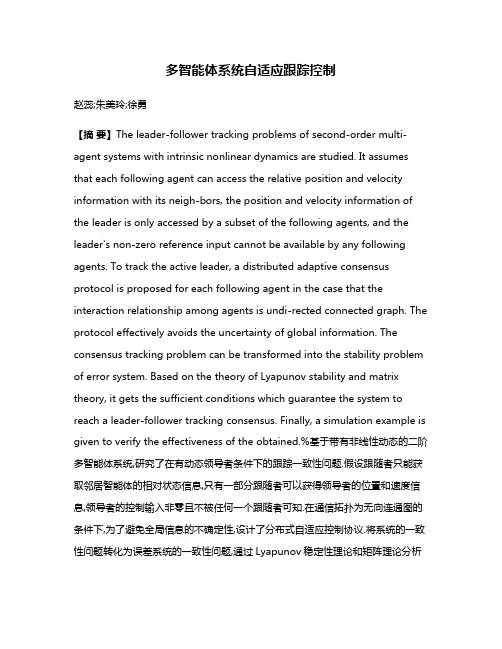
多智能体系统自适应跟踪控制赵蕊;朱美玲;徐勇【摘要】The leader-follower tracking problems of second-order multi-agent systems with intrinsic nonlinear dynamics are studied. It assumes that each following agent can access the relative position and velocity information with its neigh-bors, the position and velocity information of the leader is only accessed by a subset of the following agents, and the leader's non-zero reference input cannot be available by any following agents. To track the active leader, a distributed adaptive consensus protocol is proposed for each following agent in the case that the interaction relationship among agents is undi-rected connected graph. The protocol effectively avoids the uncertainty of global information. The consensus tracking problem can be transformed into the stability problem of error system. Based on the theory of Lyapunov stability and matrix theory, it gets the sufficient conditions which guarantee the system to reach a leader-follower tracking consensus. Finally, a simulation example is given to verify the effectiveness of the obtained.%基于带有非线性动态的二阶多智能体系统,研究了在有动态领导者条件下的跟踪一致性问题.假设跟随者只能获取邻居智能体的相对状态信息,只有一部分跟随者可以获得领导者的位置和速度信息,领导者的控制输入非零且不被任何一个跟随者可知.在通信拓扑为无向连通图的条件下,为了避免全局信息的不确定性,设计了分布式自适应控制协议.将系统的一致性问题转化为误差系统的一致性问题,通过Lyapunov稳定性理论和矩阵理论分析得到了该协议使系统达到一致的充分条件.最后用仿真例子证明了设计方法的有效性.【期刊名称】《计算机工程与应用》【年(卷),期】2017(053)018【总页数】5页(P39-43)【关键词】多智能体系统;一致性;分布式控制;自适应控制;领导者【作者】赵蕊;朱美玲;徐勇【作者单位】河北工业大学理学院,天津 300401;河北工业大学理学院,天津300401;河北工业大学理学院,天津 300401【正文语种】中文【中图分类】TP13一致性,是智能体组成的网络系统的一类集体行为,近年来由于它广泛应用在生物系统、传感器网络、无人机编队控制等领域,引起了许多学者的关注,得到了大量研究成果[1-5]。
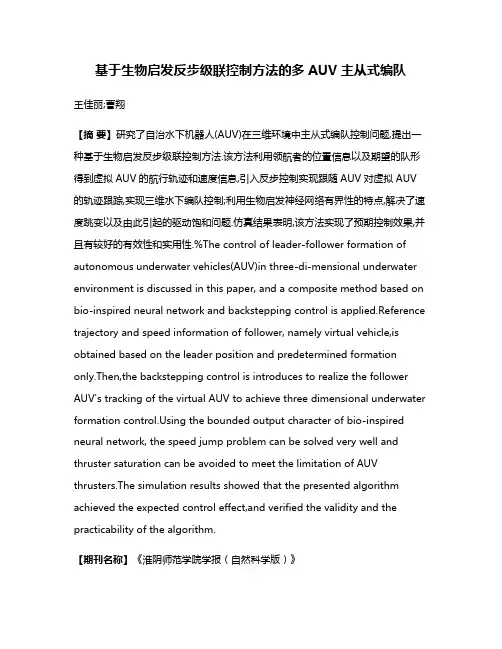
基于生物启发反步级联控制方法的多AUV主从式编队王佳丽;曹翔【摘要】研究了自治水下机器人(AUV)在三维环境中主从式编队控制问题,提出一种基于生物启发反步级联控制方法.该方法利用领航者的位置信息以及期望的队形得到虚拟AUV的航行轨迹和速度信息,引入反步控制实现跟随AUV对虚拟AUV 的轨迹跟踪,实现三维水下编队控制;利用生物启发神经网络有界性的特点,解决了速度跳变以及由此引起的驱动饱和问题.仿真结果表明,该方法实现了预期控制效果,并且有较好的有效性和实用性.%The control of leader-follower formation of autonomous underwater vehicles(AUV)in three-di-mensional underwater environment is discussed in this paper, and a composite method based on bio-inspired neural network and backstepping control is applied.Reference trajectory and speed information of follower, namely virtual vehicle,is obtained based on the leader position and predetermined formation only.Then,the backstepping control is introduces to realize the follower AUV's tracking of the virtual AUV to achieve three dimensional underwater formation ing the bounded output character of bio-inspired neural network, the speed jump problem can be solved very well and thruster saturation can be avoided to meet the limitation of AUV thrusters.The simulation results showed that the presented algorithm achieved the expected control effect,and verified the validity and the practicability of the algorithm.【期刊名称】《淮阴师范学院学报(自然科学版)》【年(卷),期】2018(017)001【总页数】5页(P22-26)【关键词】自治水下机器人;主从式编队控制;生物启发神经网络;反步控制【作者】王佳丽;曹翔【作者单位】淮阴师范学院物理与电子电气工程学院,江苏淮安 223300;淮阴师范学院物理与电子电气工程学院,江苏淮安 223300【正文语种】中文【中图分类】TP2730 引言随着对海洋的深入开发,作为开发海洋的有效工具自治水下机器人(Autonomous Underwater Vehicle,AUV)被广泛研究.由于AUV需依靠自身携带的能量工作,工作范围小,工作时间有限,从而使得多AUV协作成为当今研究的热点.编队控制作为多AUV协作的基本问题受到国内外学者的广泛关注.多AUV编队控制主要有虚拟结构法、基于行为法和主从式控制法等3种方法[1].虚拟结构方法将AUV整体编队视为一个刚体的虚拟结构,每个AUV是刚体上位置相对固定的一点[2].多机器人之间保持一定的距离和角度,可以共同组成一个几何队形,将整个“几何体”视为一个整体,即一个刚体结构.该方法对机器人的群体行为有明确的描述,机器人之间可以做到信息实时共享,从而可以稳定而相对精确的做到轨迹跟踪控制,但是要求队形作为一个虚拟结构的刚体进行运动,缺乏灵活性,目前仅用于二维环境中.基于行为的编队控制方法是将编队控制任务分解为一系列的基本行为,通过行为的综合来实现运动控制[3].基于行为法的优点是控制器设计相对简单,可以有明确的队形反馈,可以实现分布式控制,具有一定的并行性、实时性和灵活性,不足之处是群体行为没有明确的定义,很难用数学方法分析局部控制规则和保持稳定性.主从式控制方法是在多AUV系统中指定一个AUV为领航者,其他AUV为跟随者.根据领航者的信息和期望的队形,设计出一个与领航者距离固定不变的虚拟AUV,跟随者通过虚拟AUV跟踪领航者的实现编队[4].主从式控制法的优点是整个编队的航行由领航者的航行信息确定,易于操作,可以根据环境的改变及时调整队形.本文采用主从式的编队方法,并引入生物启发反步级联控制提高了编队的稳定性,解决了速度跳变以及由此引起的驱动饱和问题.1 编队控制考虑到实际的海底环境,本文假设只能获得领航AUV的位置量.此时,需要先求出期望的跟随AUV的速度量以及位置量,然后引入生物启发反步级联控制策略,为跟随AUV设计编队控制率,让跟随AUV对虚拟AUV进行轨迹跟踪,从而达到预期的编队效果.图1给出了具体编队过程,将多AUV拆分为两两一组,首先以2个AUV(包括领航AUV和跟随AUV)为例进行编队设计,然后将其扩展到7个AUV的编队,进而可以扩展到更多AUV.图1 三维主从式编队控制1.1 虚拟AUV设计虚拟AUV的设计是在仅知道领航AUV位置量ηm的情况下得到虚拟AUV的位置量ηv和速度量Vv的过程.虚拟AUV的设计包括虚拟AUV参考轨迹量设计、虚拟AUV位置量设计及虚拟AUV速度量设计3个部分.根据图1的原理,为得到虚拟AUV的位置量和速度量,设领航AUV的位置信息为ηm=[xm ym zm ψm]T,首先根据领航AUV的位置量ηm得到其参考轨迹量[5]:(1)利用其参考轨迹量ηd,并且引入辅助控制变量及相关设计参数,可得到虚拟AUV的位置量ηv[6]:(2)其中(3)(4)根据式(3)和式(4),经计算可得到虚拟AUV位置量ηv和辅助控制变量φ,将其结合式(2)可得到虚拟AUV的速度量Vv.1.2 生物启发神经网络生物启发神经网络源于Hodgkin和 Huxley[7]两位英国科学家对大西洋枪乌贼的生物薄膜研究提出的膜模型.Grossberg[8]将其模型做出进一步改进,将神经元的膜电压限制在[-D1,B1]之间,并有一个自动的增益控制.获得如下改进的生物启发模型:(5)其中表示神经元的神经活性,参数A1,B1和D1分别表示被动衰减率,神经激励的上限和下限.变量f(ei)=max(ei,0)和g(ei)=max(-ei,0)分别表示激励输入与抑制输入.根据式(5)得到单个神经元的分流动态特性.对于一个适当选择的输入信号来说,可以获得各种不同的期望结构特性,如竞争,遗忘与上下限都能从这个模型中获得.生物启发模型是一种连续的微分方程,系统输出Vi对于任何激励与抑制信号能够保证在[-D1,B1]范围内,输出信号连续而平滑.1.3 跟随AUV编队控制率设计将得到的虚拟AUV位置信息及速度信息,作为跟随AUV的期望状态,为跟随AUV 设计稳定的编队控制律,使跟随AUV跟踪虚拟AUV的轨迹,进而与领航AUV保持期望距离和角度,实现编队任务.虚拟AUV在惯性坐标系下的运行轨迹为:ηv=[xv yv zv ψv]T,速度信息:Vv=[uv vv wv rv]T,(xv,yv,zv)为惯性坐标系下虚拟AUV的位置信息,ψv为AUV绕Z轴逆时针方向转过的角度值.跟随AUV的实际航行状态定义为:ηf=[xf yf zf ψf]T.为实现编队控制任务,使AUV按照期望队形进行航行,需要控制跟随AUV的速度和角速度量Vf=[uf vf wf rf]T,使其能够跟踪虚拟AUV的轨迹,最终使惯性坐标系下编队控制误差ee收敛于0[9].(6)该控制系统的结构框图如图2所示:图2 编队控制系统基本结构框图图2编队控制系统中,利用领航AUV位置信息ηm=[xm ym zm ψm]T得到虚拟AUV速度信息Vv=[uv uv wv rv]T及位置信息ηv=[xv yv zv ψv]T.将跟随AUV 实际轨迹ηf=[xf yf zf ψf]T与虚拟AUV轨迹误差量ee=[ex ey ez eψ]T.虚拟AUV轨迹误差量根据式(6)得到平滑处理后的速度.平滑后的速度和虚拟AUV的速度值Vv=[uv vv wv rv]T共同作为反步控制的输入.反步控制方法因其控制性能简单实用,广泛应用于移动机器人中,现将其应用在三维水下环境AUV编队控制之中,对应的控制律设计也是基于三维环境的.由反步方法得到运动学编队控制律[10]:(7)式中k,kz,kψ为正常系数.2 编队控制仿真仿真过程中,要求7个AUV沿螺旋线航行完成V字型编队.首先给出领航AUV的位置信息,设定领航AUV A0的航行轨迹为螺旋线:ηm=[xm ym zm ψm]T,其中,xm=5*sin(0.2*t);ym=-5*cos(0.2*t);zm=0.15*t;ψm=0.2*t.跟随6个AUV,分别为A1,A2,A3,A4,A5,A6.仿真环境设置为:16×16×11 m3的三维环境,A1,A2跟随A0,A4跟随A2,A6跟随A4,A3跟随A1,A5跟随A3,对于A0,A2,A4,A6,队形参数设置为: λ1=2,λ2=1,λ3=4,λ4=0.5,k1=2,k2=1,k3=2,k4=0.1;对于A0,A1,A3,A5,队形参数设置为: 运动学控制律参数设置为:k=1,kz=2,kψ=2.A0首位置为[0 -5 0 0],A1首位置[-1 -4 -1 0],A2首位置[-1 -6 -1.06 0], A3首位置[ 0 -3 -2.12 0], A4首位置[-1 -7 -2.12 0],A5首位置[-1 -2 -3.18 0],A6首位置[-2 -8 -3.18 0],设定仿真时间为50 s,虚拟AUV初始位置值根据相应的期望轨迹初始值进行设定,仿真结果如图3所示.从7AUV螺旋线航行V字编队控制仿真图3可以看出,当领航AUV按照螺旋线轨迹航行时,由生物启发反步编队控制方法得到的运动学编队控制律,可以控制跟随AUV在任意设定初始位置跟踪到相应领航AUV,得到期望的编队控制队形,在AUV 航行过程中保持期望编队队形,实现编队控制任务.图3 7AUV螺旋线编队控制图4 螺旋线编队速度控制信号比较为了比较本文方法的性能,将本文方法和传统反步方法对三维螺旋线编队速度控制信号进行比较.为了实现图3所示的7AUV螺旋线航行V字编队,两种方法前10 s对A2速度控制的信号如图4所示.从图4可以看出,在编队任务开始阶段传统反步控制方法给出的速度信号往往较大,需要推进器提供较大的推力,有时会超出推进器允许的上限,结果是AUV无法按计算结果跟踪轨迹,使得 AUV的速度发生跳变,进而引起驱动器饱和.而本文方法由于引入了生物启发神经网络,其速度控制信号被限制在推进器允许范围内,因而不会出现速度跳变和驱动饱和现象.从图4中也可知,本文方法的速度控制信号比传统反步方法的速度控制信号更小.3 结论研究了三维环境中多AUV主从式编队控制问题,采用生物启发反步级联控制方法,仅利用领航AUV的位置信息,设计虚拟AUV,就能得到跟随AUV的参考轨迹及速度值,从而实现期望队形的编队.与传统反步控制方法相比,本文引入生物启发神经网络对AUV的速度进行了限制,解决了速度跳变以及由此引起的驱动饱和问题.仿真结果表明,本文提及的算法实现了预期的编队队形,与传统反步控制方法相比,提高了编队的稳定性,有更好的实用性.限于篇幅,本文未对存在障碍物和海流环境中的编队进行讨论,未来的工作将对这些方面做进一步研究.参考文献:[1] Alonso Mora J, Baker S, Rus D. Multi-robot formation control and object transport in dynamic environments via constrained optimization[J]. The International Journal of Robotics Research, 2017, 36(9): 1000-1021. [2] 潘无为,姜大鹏,庞永杰,等. 人工势场和虚拟结构相结合的多水下机器人编队控制[J]. 兵工学报,2017, 2(38): 326-334.[3] 卢洁莹,林子键,陈泳锟,等. 移动机器人编队的扩展卡尔曼姿态估计[J]. 电子设计工程,2016,08(24): 1-5.[4] 罗京,刘成林,刘飞. 多移动机器人的领航-跟随编队避障控制[J]. 智能系统学报,2017, 12(2):202-212[5] Purwar S, Kar I N, Jha A N. Adaptive output feedback tracking control of robot manipulators using position measurements only[J]. Expert systems with applications, 2008, 34(4): 2789-2798.[6] Lapierre L, Jouvencel B. Robust nonlinear path-following control of an AUV[J]. IEEE Journal of Oceanic Engineering, 2008, 33(2): 89-102.[7] Hodgkin A L, Huxley A F. A quantitative description of membrane current and its application to conduction and excitation in nerve[J]. The Journal of physiology, 1952, 117(4): 500-544.[8] Grossberg S. Nonlinear neural networks: Principles, mechanisms, and architectures[J]. Neural Networks, 1988, 1(1): 17-61.[9] Repoulias F, Papadopoulos E. Planar trajectory planning and tracking control design for underactuated AUVs[J]. Ocean Engineering, 2007, 34(11): 1650-1667.[10] 高剑, 徐德民, 严卫生. 欠驱动自主水下航行器轨迹跟踪控制[J]. 西北工业大学学报, 2010, 28(3): 404-408.。
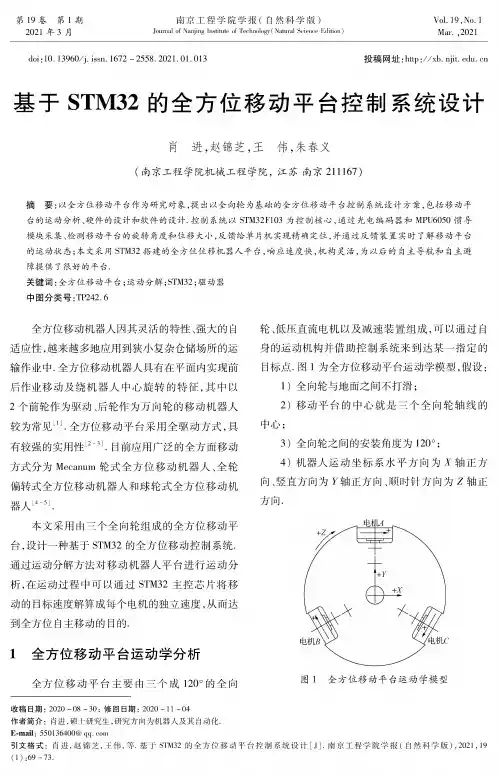
第19卷第1期 南京工程学院学报(自然科学版)V 〇L 19,N 〇.l2021 $ 3 月Journal of Nanjing Institute of Technology ! Natural Science Edition )Mar. ,2021doi:10. 13960/j. issn. 1672 -2558.2021.01.013投稿网址:http://x b. n j i t . edu. cn基于STM 32的全方位移动平台控制系统设计肖进,赵锦芝,王伟,朱春义(南京工程学院机械工程学院,江苏南京211167)摘要:以全方位移动平台作为研究对象,提出以全向轮为基础的全方位移动平台控制系统设计方案,包括移动平台的运动分析、硬件的设计和软件的设计.控制系统以S T M 32F 103为控制核心,通过光电编码器和M P U 6050惯导 模块采集、检测移动平台的旋转角度和位移大小,反馈给单片机实现精确定位,并通过反馈装置实时了解移动平台 的运动状态;本文采用S T M 32搭建的全方位位移机器人平台,响应速度快,机构灵活,为以后的自主导航和自主避障提供了很好的平台.关键词:全方位移动平台;运动分解;S T M 32;驱动器 中图分类号:T P 42.6全方位移动机器人因其灵活的特性、强大的自 适应性,越来越多地应用到狭小复杂仓储场所的运 输作业中.全方位移动机器人具有在平面内实现前 后作业移动及绕机器人中心旋转的特征,其中以 2个前轮作为驱动、后轮作为万向轮的移动机器人 较为常见[1].全方位移动平台采用全驱动方式,具 有较强的实用性目前应用广泛的全方面移动 方式分为M e c a n u m 轮式全方位移动机器人、全轮 偏转式全方位移动机器人和球轮式全方位移动机 器人[4 — 5].本文采用由三个全向轮组成的全方位移动平 台,设计一种基于S T M 32的全方位移动控制系统. 通过运动分解方法对移动机器人平台进行运动分 析,在运动过程中可以通过S T M 32主控芯片将移 动的目标速度解算成每个电机的独立速度,从而达 到全方位自主移动的目的.1全方位移动平台运动学分析全方位移动平台主要由三个成120°的全向轮、低压直流电机以及减速装置组成,可以通过自 身的运动机构并借助控制系统来到达某一指定的 目标点.图1为全方位移动平台运动学模型,假设(1"全向轮与地面之间不打滑;2"移动平台的中心就是三个全向轮轴线的 中心'3"全向轮之间的安装角度为120°4"机器人运动坐标系水平方向为Z 轴正方 向、竖直方向为F 轴正方向、顺时针方向为Z 轴正 方向.收稿日期:2020 -08 -30;修回日期:2020 -11 -04作者简介:肖进,硕士研究生,研究方向为机器人及其自动化.E-mail : 550136400@qq . com 引文格式:肖进,赵锦芝,王伟,等.基于STM 32的全方位移动平台控制系统设计[J ].南京工程学院学报(自然科学版),2021,19 ! 1 ":69 -73.70南京工程学院学报(自然科学版)2021年3月假设全方位移动平台广义速度为[),),$] 7#各轮的线速度为[),),)]T,电机!电机"、电机C的运动速度分别为)、)、),移动平台Y轴和\轴的速度分别为)和),移动平台的运动中心即为移动平台的原点(乂为电机与运动中心(的距离,$为移动平台Z轴方向的旋转速度.对全方位移动平台在三个方向上的速度进行分解,平移Y方向时,)'0,)= 0,$ = 0,可以得到:)=1 X),)=-cos600X),(1))=-cos60〇x)平移\方向时,)=0,)'0,$=0,可以得到:)=0 X),)= sin60〇X),.(2))=-sin600X)沿着Z轴方向旋转时,)=0,)=0,$'0,可以得到:)=$x*,) = $x*,) = $x* (3)将式(1"、式(2)和式(3"相加可以得到:)=1x)+ 0x)+ $x* ,)=-cos600x)+ sin60〇x)+ $x*| (4))=-cos600x)- sin600x)+ $x将式(4)转化为矩阵形式得:■)-■10*■)_)=-cos600sin600*)(5)_ - cos600-sin600* __ $_对式(E)求逆解可以得到正运动学方程为:)_■2 11 "了-了 - 了■)-)=0 槡槡3 3)(6)$_111_)__3* 3* 3* _由式(1)可知,通过调节三个全向轮电机的转 速及转向,就能达到改变整个全方位移动平台运动 状态的目的,这是进行软、硬件设计的理论基础.将移动平台的运动规律分解,然后将指定的线 速度和角速度根据公式依次分配到每个电机上,即可完成机器人的运动控制.2全方位移动平台控制系统硬件设计2.1控制系统硬件结构设计图2为基于单片机系统设计的全方位移动平 台控制系统的结构框图,处理器为M C U单片机处 理器;信号输入模块(包括蓝牙、按键和串口模块)将运动信号输入到@P U中,@P U直接对驱动器输 出不同位移的信息;传感器模块包括电机尾部的光 电码盘、@Z U6050惯导模块以及A/D转换模块,光 电码盘通过光电切割来计算移动平台位移的速度 和距离,M P U6050惯导模块用来计算移动平台移 动的加速度和旋转的角度,A/X模块将电源的模 拟量转化为数字,0L E X显示屏显示M C U通过传 感器采集的信息;运动模块由驱动芯片和低压直流 电机组成,信号输入模块输入控制信号,M C U根据 运动分解结果分配对应的电压信号到驱动芯片,驱 动芯片驱动直流电机按照指定路径运动.图2全方位移动平台控制系统2.2控制系统芯片选择设计控制系统时,从控制系统的稳定性和性能 多方面综合考虑,拟采用S T M32F103作为控制系 统的主控芯片?S T M32F103是S T(意法半导体)公司推出的 32 位单片机,具有 64 kB S R A M、512 kB F L A S H、8个定时器、3个A D C以及2个IIC,是高可靠、低 消耗、抗干扰的高性能单片机[6],具有48个GPI0接 口,完全符合全方位移动平台GPI0接口的需求.2)电机驱动模块设计全方位移动平台采用的驱动器W S X C2412X 是一*款12 A/24 V双直流有刷电机驱动器,是专门 为低压直流电机设计的,其主要特点是:工作电压第19卷第1期肖进,等(基于STM32的全方位移动平台控制系统设计71低,工作电压只需24 V;输出电流大,可高达12 A;可驱动最高290 W功率的直流电机,内置过电压、欠电压、过热保护电路,支持满占空比输入,双通道 驱动.全方位移动平台有三组电机,采用两组驱动 器即可满足驱动的要求.使用定时器输出三路P W M波,驱动时序如表1所示.以一路电机为例,其驱动器信号输入为(3A置低,I N B置高,输入 P W M波,则功率输出M A为P W M波,M B置低,电机根据输入的P W M波,按照给定速度正转;反之,I N A置高,I N B置低,输入P W M波,则功率输出M B 为P W M波,M A置低,电机根据给定速度反转.表1中H为高电平;L为低电平;X为与电平无关;Z为 高阻抗;P W M为输入的变占空比不变频率的脉宽 调制信号.表1 W S D C2412D驱动时序信入出INA INB PWM MA MB电机状态L L X L L制动L H PWM PWM L正转H L PWM L PWM转H H X Z Z脱机驱动器的主要功能就是根据M C U发出的控 制指令,通过驱动器的控制协议,输出对应的P W M波驱动电机运动.全方位移动平台配有三台电机,用两组驱动器对其进行控制,电机!和 电机"分别接入驱动器1的电机通道1与2,电机C接入驱动器2的电机通道1.以电机B为例,驱动器与电机、控制器、反馈元件的连接简图如图3所示.图3控制系统接线图2)控制器的引脚分配全方位移动平台控制系统的G P I O引脚分配 如表2所示.表2 G P I O引脚分配表GPIO复用接线GPIO复用接线地址會爸址能PB8TIM4__CH4光电r器A相PC0/电机!的动器引INAPB9TIM4__CH3光电r器B相PC1/电机!的动器引INBPB10 I2C2._SCL MPU6050SCL PC3/电机"的动器引INAPB11I2C2__SDA MPU6050SDA PC4/电机"的动器引INB电机!的电机G的PC6TIM8_CH1动器引PC5/动器引PWM INA电机"的电机G的PC7TIM8_CH2动器引PC6/动器引PWM电机G的INBPC8TIM8_CH3动器引PWM3全方位移动平台控制系统软件设计3.1软件控制流程软件的总体控制流程如图4所示,首先初始化片内资源,启动接收任务,等待外部的指令,外部指 令可以通过串口模块或者蓝牙模块传递,接收到指 令后解析该指令,并将解析后的内容发送给电机模 块,根据运动分解和P I D算法,完成电机速度的运 算,同时不断地读取电机的状态和速度,反馈给 M C U,并启动O L E D显示模块,监控移动平台的状 态及各个电机的位置和速度.该控制系统所采用的 芯片S T M32F103单片机最高晶振为72 M H z,利用 定时器的输出比较模式产生占空比可变的P W M 波来控制电机的速度,同时通过运动分解将目标速 度分配到每个电机上.在状态反馈方面,M C U通过 定时器的编码器功能来获取移动平台运动的速度 与位移,通过IIC接口连接M P U6050访问其内部72南京工程学院学报(自然科学版)2021年3月的数据寄存器获取移动平台的角度与加速度信息?图4全方位移动平台主控制流程3.2 P I D速度环模型增量式PID算法定义为:1 _ J, )ek1)ek-1_式中:7为第,欠采样输入偏差值;J为比例时间;J为微分时间.电机控制速度环原理图如图E所示,电机采用 速度控制,MCU接收串口模块输入的指令,将机器 人的目标速度作为入口参数,通过式(1)至式(6)进 行运动学分析,计算出每个电机的目标速度,并通过 速度PID控制器,驱动直流电机,直流电机尾部的编 码器捕获电机的速度,将速度反馈给P D控制器,PID 控制器调节PWM波的输出量,从而达到闭环控制?图5 电机控制速度环原理图4调试试验与分析在搭建的全方位移动平台上选择z轴方向作为误差基准,通过多次测量z轴方向的数据求取 整个系统的平均误差,全方位移动平台如图6 所示.图6 图通过Python测试脚本,测量位置为10 m、角度 为0°时的位姿,共采集7组数据,如表3所示,并对数据进行分析,可以得出误差统计图如图7所示.3(组号位Bm实位Bm目标角度/°实Bm位Bm角度误差/°110.00010.0160.0000.1020.0160.102 210.00011.6910.000-0. 105 1.691-0. 105 310.00010.0970.0000.0160.0970.016 410.00010.3010.0000.2560.3010.256 510.0009.7950.000-0. 136-0.205-0. 136 610.0009.7480.0000.235-0.2520.235 710.00010.1780.000-0.2120.178-0.212门□位置误差□角度误差_ 1.5、-1.0 _-0.52 3 4 5 6 7采集数据组图7误差统计图从图7可以看出,除了第二组数据偏差较大 外,其他数据的位置误差均保持在0.5 m之内,角度误差保持在0.3°Z内,试验表明移动平台的精 度较高?5结语本文设计了一种全方位移动平台的运动控制 系统,该系统充分利用了全向轮的全驱动特性,能 够根据输入的指令和MCU的运动分解来完成运动 目标任务,通过光电传感器、MPU6050等传感器可-0.5^-第19卷第1期肖进,等:基于S T M32的全方位移动平台控制系统设计73以清晰地反馈移动平台的旋转角度和位移距离,控 制更加灵活,满足了移动平台对于控制系统的要 求;同时以S T M32作为控制核心,通过与传感器之 间的通信,能够实时了解移动平台自身的状态,实 现了良好的通讯;通过驱动芯片W S D C2412D实现 对低压直流电机的精确控制;最后通过试验测量本 移动平台的定位精度,验证了移动平台具有较高的 定位精度,为后续的移动机器人上层的继续搭建提 供了良好的平台.参考文献:[1] LORIA A,DASDEMIR J,JARQUIN N A.Leader followerformation and tracking control of mobile robots along straightp a t h s)J]•IEEE T r a n s a c t i o n s o n C o n t r o l S y s t e m s T e c h n olog y,2016,24(2) :727 -732.[2]贾茜,汪木兰,刘树青,等.全方位移动机器人研究综述[J].制造业自动化,2015,37(7): 131-134.[3]周卫华,张德发•四轮移动机器人平台的设计与实现[J]•电气自动化,2018,40(5) :10-12.[4 ]付宜利,李寒,徐贺,等.轮式全方位移动机器人几种转向方式的研究[J]•制造业自动化,2005,27(10):33-37.[5]王兴松•Mecnum轮全方位移动机器人技术及其应用[J]•机械制造与自动化,2014,43(3):1-6.[6]胡春旭,熊枭,任慰,等.基于嵌人式系统的室内移动机器人定位与导航[J]•华中科技大学学报(自然科学版),2013,41(S1) :254-257,266.Designof Control Systemof Omnibearing Mobile PlatformBasedonSTM32 XIAO Jin, ZHAOJindhi, WANG Wei, ZHUChun-yi(School of Mechanical Engineering,Nanjing Ins tit ute of Technology,Nanjing211167, China)Abstract:This paper takes omnidirectional mobile platform as a research object, and proposes a design scheme for omnidirectional mobile platform control system based on omnidirectional wheels. Emphasis i s placed on hardware design and software design o f the mobile platform. With STM32F103 as a control core, the research collects and detects the rotation angle and displacement of the mobile platform through a photoelectric encoder navigation module, which i s then fed back t o the single-chip microcomputer t o achieve precise positioning. Understanding of the movement status of the mobile p latform in real time i s obtained by using a feedback device. The omnidirectional displacement robot platform built using STM32 has fast response speed and flexible mechanisplatform for autonomous navigation and autonomous obstacle avoidance in the future.Key words: omnidirectional mobile platform; motion decomposition; STM32; drive。
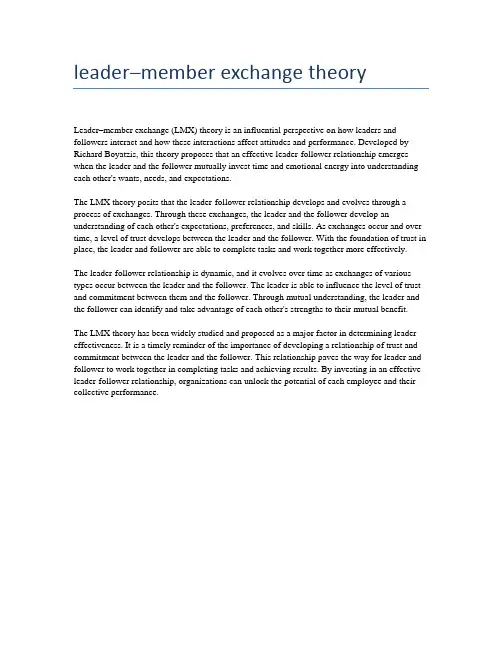
leader–member exchange theoryLeader–member exchange (LMX) theory is an influential perspective on how leaders and followers interact and how these interactions affect attitudes and performance. Developed by Richard Boyatzis, this theory proposes that an effective leader-follower relationship emerges when the leader and the follower mutually invest time and emotional energy into understanding each other's wants, needs, and expectations.The LMX theory posits that the leader-follower relationship develops and evolves through a process of exchanges. Through these exchanges, the leader and the follower develop an understanding of each other's expectations, preferences, and skills. As exchanges occur and over time, a level of trust develops between the leader and the follower. With the foundation of trust in place, the leader and follower are able to complete tasks and work together more effectively.The leader-follower relationship is dynamic, and it evolves over time as exchanges of various types occur between the leader and the follower. The leader is able to influence the level of trust and commitment between them and the follower. Through mutual understanding, the leader and the follower can identify and take advantage of each other's strengths to their mutual benefit.The LMX theory has been widely studied and proposed as a major factor in determining leader effectiveness. It is a timely reminder of the importance of developing a relationship of trust and commitment between the leader and the follower. This relationship paves the way for leader and follower to work together in completing tasks and achieving results. By investing in an effective leader-follower relationship, organizations can unlock the potential of each employee and their collective performance.。
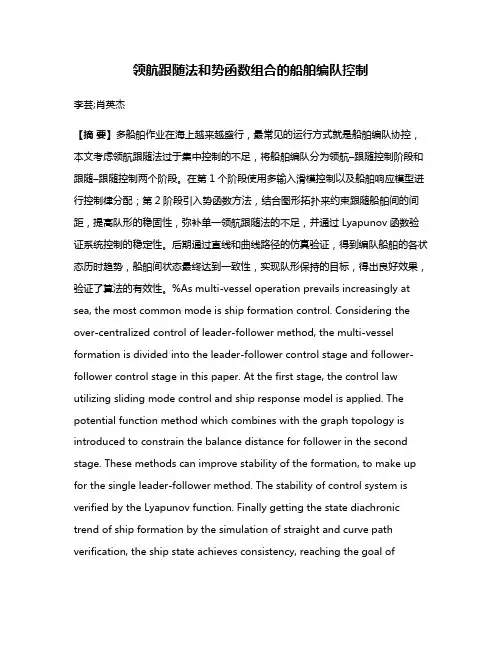
领航跟随法和势函数组合的船舶编队控制李芸;肖英杰【摘要】多船舶作业在海上越来越盛行,最常见的运行方式就是船舶编队协控,本文考虑领航跟随法过于集中控制的不足,将船舶编队分为领航–跟随控制阶段和跟随–跟随控制两个阶段。
在第1个阶段使用多输入滑模控制以及船舶响应模型进行控制律分配;第2阶段引入势函数方法,结合图形拓扑来约束跟随船舶间的间距,提高队形的稳固性,弥补单一领航跟随法的不足,并通过Lyapunov函数验证系统控制的稳定性。
后期通过直线和曲线路径的仿真验证,得到编队船舶的各状态历时趋势,船舶间状态最终达到一致性,实现队形保持的目标,得出良好效果,验证了算法的有效性。
%As multi-vessel operation prevails increasingly at sea, the most common mode is ship formation control. Considering the over-centralized control of leader-follower method, the multi-vessel formation is divided into the leader-follower control stage and follower-follower control stage in this paper. At the first stage, the control law utilizing sliding mode control and ship response model is applied. The potential function method which combines with the graph topology is introduced to constrain the balance distance for follower in the second stage. These methods can improve stability of the formation, to make up for the single leader-follower method. The stability of control system is verified by the Lyapunov function. Finally getting the state diachronic trend of ship formation by the simulation of straight and curve path verification, the ship state achieves consistency, reaching the goal ofmaintaining the formation, which obtains good results and tests the effectiveness of algorithm.【期刊名称】《控制理论与应用》【年(卷),期】2016(033)009【总页数】6页(P1259-1264)【关键词】船舶编队;领航跟随;势函数;图形拓扑【作者】李芸;肖英杰【作者单位】上海海事大学商船学院,上海201306;航运仿真技术教育部工程研究中心,上海201306【正文语种】中文【中图分类】TP273近年来,除了对单艘船舶的航向控制、轨迹跟踪之外,船群控制也得到越来越多的重视,如拖带系统稳定性控制、船舶补给控制以及船舶编队控制,对于多船之间的协作航行策略已成为当今研究的热点.船舶编队主要是指控制多艘船舶按照一定的队形,执行某项任务,已被广泛地应用于海上勘测、海上搜救、海底作业等多个方面.目前,常见的编队控制方法有领航跟随法、基于行为法、虚拟结构法和图论法等,它们都是通过群体中个体间的信息沟通,建立控制策略,再对个体实现逐一控制来达到预期目标.针对船舶群体的编队控制,主要有船队队形保持、船队避障以及自适应3个研究方向,刘杨等[1]基于领航跟随法设计非线性速度和路径跟踪控制器,使得船队之间可以跟踪任意期望队形;付明玉等[2]使用虚拟领航者,结合无源性相关理论,构建路径跟踪控制器,进行船队队形保持;夏盈盈等[3]设计圆形队形轨迹,利用反馈控制设计控制策略,进行轨迹控制;Chao等[4]结合图论拓扑理论,进行编队控制律设计,利用Lyapunov函数验证稳定性能,保障队形稳定;Khoshnam[5]根据领航跟随法,使用径向基函数神经网络进行适应逼近,来抵抗船舶编队中的风浪干扰影响,维持船队稳定;K.D.Do[6]建立椭圆状的船舶领域防止船队间碰撞,并结合控制律设计实现期望队形,仿真得出较好表现;胡凤娟[7]在论文中研究基于领航跟随法的编队控制,以及模糊改进的人工势场避障方法,得到良好效果;赵园等[8]运用虚拟结构法,构造碰撞函数,研究船队避障策略;刘杨等[9]等采用神经网络方法,建立船舶之间协调的自适应控制律,保证编队系统的跟踪误差一致有界;彭周华[10]选择反演法、动态面法以及神经网络法进行鲁棒自适应控制设计,分析编队的稳定性能,并相互对比控制效果.以上方法都是利用船舶个体间的运动关联对个体进行分别控制,设计运动学和动力学两方面的控制策略,保障船队间编队稳定协调.本文延续这个思路,使用领航跟随法结合图形拓扑理论,而跟随法过于集中控制,一旦领航者失效,则影响整个编队性能.为弥补领航者集中式控制的不足,文中引入混合式模式,将船舶编队分为领航-跟随控制阶段和跟随-跟随控制阶段.参照各阶段的运动响应模式,分别构建控制策略,降低对领航者的依赖,减小跟踪误差,达到一致性协议.并构造Lyapunov函数验证其稳定性能,最终实现队形稳定. 2.1 船舶系统模型(Ship system model)对于水面船舶,考虑三自由度的欠驱动模型,由动力学模型推导得到的响应模型如下[11]:运动学模型为其中:K,Kv,T1,T2为船舶操纵参数,δ为舵角,u,v,r为船舶的纵向、横向和艏摇角速度,m11为船舶惯性分量,φ为船舶航向,x,y为船舶在地球坐标系下的位移.2.2 船舶编队模式(The mode of ship formation)为了使得队形中的船舶保持固定的间距和同样的航向航行,使用领航跟随法,将队形控制问题转化为跟随船舶跟踪领航者的航向和位置的问题.从船队中选择一艘船舶作为船舶领航者,给予期望路线航行,队中其他船舶将通过设计合适的控制律,跟随领航船舶进行航行调节,使得船队整体保持一致性按照一定的队形航行.根据图1可以得到领航者与跟随者之间相对距离关联.其中:xl,yl为领航船舶位置坐标,xf,yf为跟随船舶位置坐标,φl,φf分别为领航船舶和跟随船舶航向,l为领航与跟随船舶间距离,lx,ly为间距的横、纵分量.由于船舶间要保证固定的距离,即lx→lxd,ly→lyd.则对式(3)求导得出其中:lxd,lyd为横纵间距分量期望值,lxe,lxe为横纵间距分量的误差值,ul,vl,rl为领航者的纵向、横向和艏摇角速度,uf,vf,rf为跟随者的纵向、横向和艏摇角速度.编队中要保证式(4)中差值趋于零,可导出uf→ul,vf→vl.则领航船舶和跟随船舶速度、航向和间距趋于一致,实现了队形控制.但是领航法这种集中式控制,忽略了跟随者个体之间的交流关联.因此还需要考虑跟随者与跟随者间的互联,增强整个队形的稳控能力.2.3 控制形式(The mode of control)根据上节所知,将编队控制分为领航-跟随和跟随-跟随两个控制阶段.其领航-跟随主要是利用式(4)中关联设计控制律,使得跟随船舶可以很好地跟进领航船舶,到达与领航者运动一致的目的;跟随-跟随主要是指跟随船舶间通过控制律设计,维持一定的船间距离,从而提高整个队形稳定态势.跟随船舶i的控制流程如图2所示.最终领航船舶按照期望规定路径航行,跟随船舶与领航船舶达到一致,它们都按照固定队形航行,即保证其中η=[u v r]T,实现维持船队队形的控制目的.3.1 队形拓扑(Formation topology)在编队船舶中,由于彼此之间需要获取对方的位置、自由度等信息,通过感知沟通来进行队形协调,从而形成了一个彼此关联的拓扑结构.本文运用图论理论,将船舶编队转化为某种拓扑结构,船队形式化为具有数学意义的简化模式.图是指有序三元组(V,E,φ),V是非空顶点集,E是边集,φ是边集到顶点集中元素有序对或无序对簇V×V的函数,称为关联函数.对于船舶编队来说,每艘船舶可以看作一个节点,即V中元素,根据不同的队形,其间的通信链路形成边集E,节点间构成的无序对形成关联集φ.V与E的关联关系可以体现在邻接矩阵中,邻接矩阵是指:A=(aij),其中aij在无向图中表示连接节点i和节点j的边的数目[12-13].图的Laplacian矩阵定义为:L=Δ-A,n维Laplacian矩阵定义为⊗为Kronecker 积.对于无向图,满足即为正半定矩阵.根据具体的队形形式,将含有领航与跟随模式的船队建立为图形拓扑,运用邻接矩阵分析之间的连通性能,得出其约束关联.进而根据领航-跟随阶段与跟随-跟随阶段的不同,分别设计控制律.3.2 领航-跟随阶段控制设计(The controller design of leader-follower stage)领航-跟随阶段,主要是根据领航船舶与跟随者的间距关联(见式(4)),来指导跟随船舶调整自身信息按照期望航行.现对式(4)做非奇异线性变换,引入新的状态变量z:为了求解式(7)中的跟随者的速度信息,利用滑模变结构思想[14],建立多输入的滑模面函数其中m>0,为增益参数.采取指数趋近律来减弱系统抖振,其中k1>0,ε>0.将s代入得出将其分解,得到对纵、横速度的控制律:定义Lyapunov函数令参数代入式(10),求导得出则式(10)系统,在对应的控制律下保持稳定.由此得出跟随船舶预期的纵向速度和横向速度uf,vf,接下来根据此预期,将进行跟随船舶的动力学控制.现依据式(1)进行跟随船舶自身航行的调节.将纵速方程展开为式中根据上面运动学推导出的预期纵向速度,为实现与领航船舶的间距保持,令ud→uf.再把式(1)中横向速度二阶方程进行增广展开:其中:同样使用滑模控制和指数趋近律得出控制律为其中:为期望的横向速度量,其误差向量这里为可调的增益参数.此时,构造得出则横向速度控制系统达到稳定,同样为保持与领航船舶的间距,令xd→vf.接着利用求解出的控制律µ转为δ变化,根据式(1)中航向角速度模型求解出跟随船舶航向变化,完成跟随船舶的自身调控.在这个控制阶段,主要是实现跟随与领航船舶之间的间距、速度等信息的一致调节,引入滑模变结构控制特色,有效地抵抗内部参数干扰以及外部干扰影响,实现系统的稳定控制.整个流程如图3所示.3.3 跟随-跟随阶段控制设计(The controller design of follower-follower stage)在领航法中所有跟随信息都是来自领航船舶,而不关心相邻跟随者的信息,造成集中式的控制方式,忽略了跟随者之间的行为.而跟随者与跟随者之间的间距关联也影响着整个编队保持,一旦某个跟随者没能及时接收领航者信息,可靠相邻跟随者的信息进行补偿,缓解信息交流不畅或延时等状况造成的影响.船舶编队属于多智能体问题,跟随船舶之间由于要保持一定的距离,相当于在整个群体中存在一定的虚拟场来维持距离平衡.势函数就是描述个体间距离关联的函数,如机器人碰撞中有避碰势函数,以及队形势函数,现将其引用到跟随船舶间的距离保持[15-16].定义群内部势函数Uij是一个关于两个智能体i,j之间相对距离‖rij‖的非负、可微、无界的函数,rij=ri-rj,并满足以下条件:1)当‖rij‖→0时,Uij(‖rij‖)→∞.2)当个体i与个体j之间距离‖rij‖达到一定值时,Uij存在最小值.则根据定义构造如下势场函数[11]:其中:c1>0为增益系数,d是预先设定的两个相邻个体间的平衡距离.则在一定队形拓扑下,跟随者i的控制输入为其中:为单位向量表示方向.这个控制输入体现了跟随船舶与其相关连的跟随船舶间距离的制衡,控制时根据图2的思想,将每个跟随者之间的势函数控制律ξ映射到船舶坐标系u-v分量后附加到图3的u,v控制中,完成总体的控制输入.构造Lyapunov函数为[17]求导得出在船舶坐标系下将控制律ξ转化为u-v分量后代入式(19),并利用图论中Laplacian矩阵可得因此,跟随船舶间逐渐趋于期望的平衡距离,同时速度亦趋于一致.综上所述,通过以上两个阶段的控制设计,实现了跟踪领航船舶以及协调相邻跟随船舶间距的目标.同时经验证分析,保障了编队队形的稳定性能.船舶编队采用人字状态,根据图论原理,结构中船舶间信息流图是连通的,具体见图4.1为领航船舶,此时邻接矩阵为船舶和控制律中参数取K=0.943,Kv=9.7,k1=3.5,k3= 0.16,k4=0.15,ε0=0.5,m=2,c=1.84,c1=2,λ= 1.8.船舶的初始状态设为5艘船舶的初始位置依次设为[22,22],[15,15],[7,33],[0,0],[0,40],队形间距为15.先研究直线路径时编队状况,预期航线为φd= 30°,ud=3 m/s,领航船舶按照此路线航行.对跟随船舶进行编队控制,得到仿真结果.图5显示初期由于受到初始位置影响,编队间距不一致.随着整体的控制调节,间距逐渐保持一致,队形稳定实现编队的跟踪.为了保持队形一致,同时进行速度和舵角的调整,见图6和图7中的纵向速度、横向速度、航向变化以及舵角趋势,在编队初期各状态呈现波动变化,跟随船舶通过控制律进行姿态调整,逐渐向期望目标靠近,最终每艘船舶趋于一致,达到编队控制目的.当期望路径选取时,观测编队大转弯的曲线变化趋势.如图8和图9所示,初期轨迹变化波动较大,由于转弯曲率不同,为了保持间距使得速度发生较大变化,到后期渐渐平稳,速度和间距都趋于一致.因此,在转弯时会对船舶编队产生不利影响,但随着控制调整最终可以保持预期队形.本文针对船舶编队控制进行算法设计,改进了领航跟随法的过于集中问题.利用势函数实现跟随者之间的相互协调控制,提高队形的稳固性,结合图论思想和滑模理论,提出新型编队控制律运用于队形维持,并使用Lyapunov函数验证了队形的稳定性.后期通过仿真验证,得到良好的效果,对船舶编队航行提供参考,今后可对大风浪干扰影响下的队形恢复能力进行进一步研究.李芸(1988-),女,博士研究生,目前研究方向为船舶运动控制及品质,E-mail:*****************;肖英杰(1959-),男,教授,博士生导师,目前研究方向为港航论证、载运工具与应用工程.【相关文献】[1]LIU Yang,LIU Meijie.Stability analysis and antiwindup design of uncertain discrete-time switched linear systems subject to actuator saturation[J].Control Engineering,2013,20(5):980-989.(刘杨,刘美杰.基于领导跟随的欠驱动船舶编队跟踪控制[J].控制工程,2013,20(5):980-989.)[2]FU Mingyu,JIAO Jianfang.Passive coordinated formation control for vessels based on virtual leader[J].Acta Automatica Sinica Applications,2014,40(3):439-448.(付明玉,焦建芳.基于虚拟领航者的船舶无源协调编队控制研究[J].自动化学报,2014,40(3):439-448.)[3]XIA Yingying,SUN Hongfei.Circular formation control of a ship fleet based on the cyclic-pursuit strategy[J].Journal of Xiamen U-niversity,2015,54(1):93-98.(夏盈盈,孙洪飞.基于循环追踪的船舶圆形编队控制[J].厦门大学学报,2015,54(1):93-98.)[4]MA C,ZENG Q S.Distributed formation control of 6-DOF autonomous underwater vehicles networked by sampled-data information under directed topology[J].Neurocomputing,2015,154:33-40.[5]SHOJAEI K.Leader-follower formation control of underactuated autonomous marine surface vehicles with limited torque[J].Ocean Engineering,2015,105:196-205. [6]DO K D.Formation control of underactuated ships with elliptical shape approximation and limited communication ranges[J].Automatica,2012,48(7):1380-1388.[7]HU Fengjuan.The research of ship formation and obstacle avoidance under the dynamic environment[D].Guangzhou:Guangdong University of Technology,2013.(胡凤娟.动态环境下多船编队及避障研究[D].广州:广东工业大学,2013.)[8]ZHAO Yuan,GUO Ge,DING Lei,et al.Collision/obstacle avoidance control of vessel formation[J].Information and Control,2012,41(4):425-433.(赵园,郭戈,丁磊,等.舰船编队的避障/避碰控制[J].信息与控制,2012,41(4):425-433.)[9]LIU yang,GUO Chen,LIU Zhengjiang,et al.Control method of underactuated surface ship formation based on stable adaptive neural network control law[J].Journalof Traffic and Transportation Engineering,2014,14(3):120-126.(刘杨,郭晨,刘正江,等.基于神经网络稳定自适应的欠驱动水面船舶编队控制方法[J].交通运输工程学报,2014,14(3):120-126.)[10]PENG Zhouhua.Robust adaptive control for formations of marine surface vessels [D].Dalian:Dalian Maritime University,2011.(彭周华.舰船编队的鲁棒自适应控制[D].大连:大连海事大学,2011.)[11]JIA Xinle,YANG Yansheng.Mathematical Model of Ship Motion:The Mechanism Modeling and Identification Modeling[M].Dalian:Dalian Maritime University Press,1999.(贾欣乐,杨盐生.船舶运动数学模型:机理建模与辨识建模[M].大连:大连海事大学出版社,1999.)[12]XU Junming.Graph Theory and Its Application[M].Hefei:University of Science and Technology of China Press,2004.(徐俊明.图论及其应用[M].合肥:中国科学技术大学出版社,2004.)[13]LUO Xiaoyuan,LI Xu,LI Shaobao,et al.Distributed discrete-time formation control of multi-agent systems under fixed and switching topologies[J].Control and Decision,2013,28(12):1869-1873.(罗小元,李旭,李绍宝,等.分布式离散多智能体系统在固定和切换拓扑下的编队控制[J].控制与决策,2013,28(12):1869-1873.)[14]YU Chi,GONG Minglong.Design of sliding mode controller for MIMOsystemanditsapplication[J].JournalofNortheasternUniversity(Natural Science),2012,33(4):473-475.(于驰,宫明龙.多输入多输出系统的滑模控制器设计及其应用[J].东北大学学报(自然科学版),2012,33(4):473-475.)[15]YU Hui.Multi-agent robot coordinated control study and stability analysis[D].Wuhan:Huazhong University of Science and Technology,2007.(俞辉.多智能体机器人协调控制研究及稳定性分析[D].武汉:华中科技大学,2007.)[16]SONG Yanrong,WANG Xingping,ZHANG Shudong,et al.Safeguarded formation control via the artificial potential method[J].Journal of Naval Aeronautical and Asrtongautical University,2011,26(6):622-627.(宋艳荣,王兴平,张术东,等.基于势函数的护卫队形控制[J].海军航空工程学院学报,2011,26(6):622-627.)[17]CHU Fufang,YANG Hongyong.Flocking motion and speed synchronization ofmulti-agent system with disturbance[J].Complex Systems and Complexity Science,2015,12(1):85-91.(褚福芳,杨洪勇.具有干扰的多自主体系统的群集运动与速度同步[J].复杂系统与复杂性科学,2015,12(1):85-91.)。
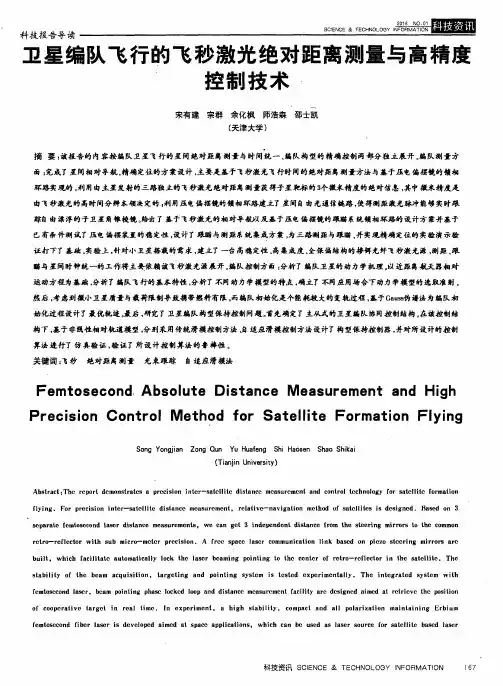
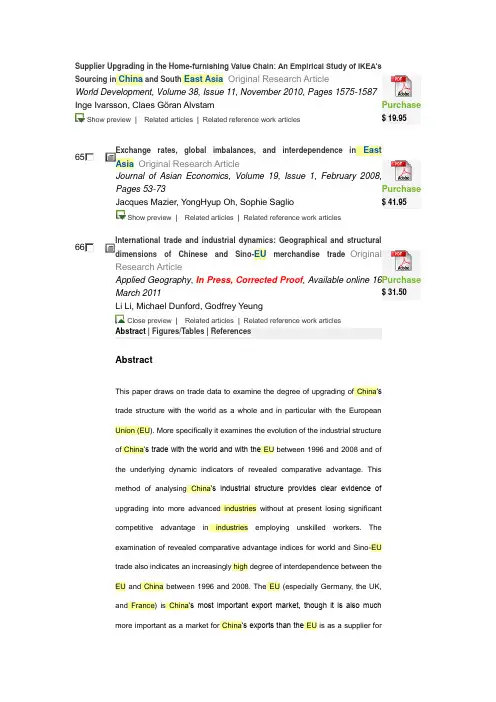
Supplier Upgrading in the Home-furnishing Value Chain: An Empirical Study of IKEA’sSourcing in China and South East Asia Original Research ArticleWorld Development , Volume 38, Issue 11, November 2010, Pages 1575-1587 Inge Ivarsson, Claes Göran Alvstam Show preview | Related articles | Related reference work articlesPurchase $ 19.9565Exchange rates, global imbalances, and interdependencein East Asia Original Research ArticleJournal of AsianEconomics , Volume 19, Issue 1, February 2008, Pages 53-73 Jacques Mazier, YongHyup Oh, Sophie SaglioShow preview | Related articles | Related reference work articlesPurchase$ 41.9566 International trade and industrial dynamics: Geographical and structuraldimensions of Chinese and Sino-EU merchandise tradeOriginalResearch ArticleApplied Geography , In Press, Corrected Proof , Available online 16 March 2011Li Li, Michael Dunford, Godfrey Yeung Close preview | Related articles | Related reference work articlesAbstract | Figures/Tables | ReferencesAbstractThis paper draws on trade data to examine the degree of upgrading of China ‘strade structure with the world as a whole and in particular with the EuropeanUnion (EU). More specifically it examines the evolution of the industrial structureof China ‘s trade with the world and with the EU between 1996 and 2008 and ofthe underlying dynamic indicators of revealed comparative advantage. Thismethod of analysing China ‘s industrial structure provides clear evidence ofupgrading into more advanced industries without at present losing significantcompetitive advantage in industries employing unskilled workers. Theexamination of revealed comparative advantage indices for world and Sino-EUtrade also indicates an increasingly high degree of interdependence between theEU and China between 1996 and 2008. The EU (especially Germany, the UK,and France) is China ‘s most important export market, though it is also muchmore important as a market for China ‘s exports than the EU is as a supplier forPurchase$ 31.50China. China‘s consequent trade surplus with the EU has gradually shifted from textiles and clothing to machinery and furniture. Further investigation reveals that the complementary Sino-EU bilateral trade is moving towards intra-industry trade at the 4-digit level of HS (Harmonization System) commodity classification. Although China is still a ‗global sweatshop‘ with a strong specialization in labour-intensive commodities produced for economically developed countries (by importing machinery, raw materials and exporting processed goods), there are signs of technological upgrading in number of selected sectors in China, noticeably electronics, computers and telecommunications equipment. China‘s reliance of imports of minerals indicates however that energy and resource security could be an important constraint on China‘s long-term economic development.Article OutlineIntroductionComparative advantage, specialization and international trade: theoretical ideas and empirical measurementComparative advantage, international trade and industrial upgradingMeasuring revealed comparative advantageTrade data sources and methodsThe geography of Chinese bilateral trade: complementarities and competiveness Structural changes in Chinese merchandise tradeChanging profiles of Chinese merchandise tradeChanging RCA of Chinese commodities: a sign of industrial upgrading? Structural upgrading in Sino-EU trade: CAs of Chinese commodities ConclusionsAcknowledgementsReferences67The impact of information andcommunication technology (ICT), education and regulation on economic freedom in Islamic MiddleEastern countries Original Research Article Information & Management , Volume 46, Issue 8, December 2009, Pages 426-433Farid Shirazi, Roya Gholami, Dolores Añón Higón Close preview | Related articles | Related reference work articlesAbstract | Figures/Tables | ReferencesAbstractOur study investigated the impact of ICT expansion on economic freedom in the Middle East (Bahrain, Iran, Jordan, Kuwait, Lebanon, Oman, Qatar, Saudi Arabia, Syria, United Arab Emirates, and Yemen). Our empirical analysis used archival data from 1995 to 2005; it showed that ICT expansion in the Middle East has been effective both in bridging the digital divide and also in promoting economic freedom in a region that was vulnerable to political, social, and global conflict. However, differences between countries, such as the educational attainment of their citizens and institutional resistance to technology acceptance, both enhanced and restricted the relationship between ICT and economic freedom.Article Outline1. Introduction2. Background2.1. ICT development in the Middle East2.2. ICT and economic development in the Middle East3. Estimation framework3.1. Economic freedom3.2. ICT3.3. Political rights and civil liberties3.4. Economic growthPurchase$ 31.503.5. Regulation3.6. Educational attainment3.7. Research model4. Data sources and descriptive statistics4.1. The economic freedom index4.2. ICT index4.3. Regulation4.4. Educational attainment4.5. Annual growth rate of GDP per capita4.6. The Index of Political Rights and Civil Liberties (PRCL)5. Empirical results5.1. The importance of education and regulation6. ConclusionAcknowledgementsAppendix A.AppendixAppendix B. AppendixReferencesVitae68Asia, Africa, Middle EastRenewable Energy Focus, Volume 10, Issue 5, September-October2009, Page 8Close preview | Related articles | Related reference work articlesAbstractNo abstract is available for this article.Purchase$ 41.9569The geography of the Spanish airport system: spatial concentration anddeconcentration patterns in seat capacity distribution,2001–2008Original Research ArticleJournal of Transport Geography, Volume 19, Issue 2, March 2011,Pages 244-254Pere Suau-Sanchez, Guillaume BurghouwtClose preview | Related articles | Related reference work articlesAbstract | Figures/Tables | ReferencesPurchase$ 41.95AbstractThis paper analyzes the geography of seat capacity at Spanish airports between 2001 and 2008. Concentration and deconcentration patterns for different markets have been identified. For this purpose, we use the Herfindahl–Hirschman Index (HHI), the Concentration Ratio (CR) and the Lorenz curve. From our analysis, we conclude that seat capacity follows a deconcentration pattern due to the growth of low-cost carriers at small- and medium-sized Spanish airports. This is in line with earlier studies for Europe as a whole. Intercontinental seat capacity still remains very much concentrated in Madrid and, to a lesser extent, in Barcelona. However, new strategies by long-haul airlines bypassing the primary European hubs foster the deconcentration of seat capacity in the Asian and North American markets. In the case of Spain, the recent liberalization of the EU–US market may become an important enabler of such network strategies, e.g., Delta has operated a route from Valencia to New York-JFK since 2009. In other intercontinental markets, capacity is more and more concentrated in Madrid. We highlight the restructuring of Iberia‘s network as an important factor behind the increasing dominance of Madrid in intercontinental markets.Article Outline1. Introduction2. Data and methodology3. The Spanish airport system4. Deconcentration processes4.1. Low-cost carriers: the main deconcentration engines4.2. North America: US carriers, engines for deconcentration4.3. Asia: difficulties in establishing stable routes5. Concentration processes5.1. Iberia‘s gateway to Latin America at Madrid-Barajas 5.2.Middle East: airlines intensify their operations at Madrid-Barajas 5.3. Africa: a future opportunity?6. ConclusionsAcknowledgementsAppendix AReferences70Managing innovation for economic development in greater China: The origins of Hsinchu and Zhongguancun Original Research ArticleTechnology in Society, Volume 32,Issue 2, May 2010, Pages 110-121 Cheng-Hua TzengClose preview | Related articles | Related reference work articles LOADING....Purchase$ 41.9571Technology clubs, R&D and growth patterns: Evidencefrom EU manufacturing Original Research ArticleEuropean Economic Review , Volume 54, Issue 1, January 2010, Pages 60-79 J.W.B. Bos, C. Economidou, M. KoetterClose preview | Related articles | Related reference work articles Abstract | Figures/Tables | ReferencesAbstractThis paper investigates the forces driving output change in a panel of EU manufacturing industries. A flexible modeling strategy is adopted that accounts for: (i) inefficient use of resources and (ii) differences in the production technology across industries. With our model we are able to identify technical, efficiency, and input growth for endogenously determined technology clubs. Technology club membership is modeled as a function of R&D intensity. This framework allows us to explore the components of output growth in each club, technology spillovers and catch-up issues across industries and countries.Purchase$ 31.50Article Outline1. Introduction2. Methodology2.1. A stochastic frontier production model2.2. Technology clubs2.3. Decomposing output growth3. Data4. Results4.1. Do industries use different technologies?4.1.1. Do industries change technology club membership?4.2. How do industries grow?4.2.1.Is there any evidence of leader–follower behavior?4.2.2. Does openness increase efficiency?4.2.3. Is there any evidence of technological catch-up?5. ConclusionAcknowledgementsAppendix A. Data and sourcesReferences72Identifying shocks in regionally integrated East Asian economies withstructural VAR and block exogeneity Original Research ArticleMathematics and Computers in Simulation, Volume 81, Issue 7,March 2011, Pages 1353-1364Kiyotaka Sato, Zhaoyong Zhang, Michael McAleerClose preview | Related articles | Related reference work articlesAbstract | Figures/Tables | ReferencesAbstractIn this paper we use a structural VAR model with block exogeneity to investigateif external shocks originating from the USA played a dominant role in influencingPurchase$ 31.50the macroeconomic fluctuations in East Asia during the period 1978–2007. The empirical results show a dynamic effect of external shocks, implying that, eventhoughregional integration appears tobe deepening and accelerating, especially after the recent global financial crisis, the influence of US shocks onreal output fluctuations in the East Asian region is still very strong. The effects ofChinese shocks show an increasing trend over time, butthe impacts are still small and not comparable with those of US shocks. The world oil price shock hasbecome increasingly important in influencing the stability of real output growth inthe region. The results from variance decomposition andimpulse response analysis confirm the findings. Even though Japanese firms have establishedproduction networks in East Asia through trade and investment, and China hasalso grown rapidly and become a key regional country, the results suggest thatUS influence in the region is still asymmetric and strong. Therefore, it is difficultto conclude that shocks to the East Asian economies have become moreregionally oriented.Article Outline1. Introduction2. Analytical framework3. Data4. Empirical results5. Concluding remarksAcknowledgementsReferences73Can China’s Growth be Sustained? A Productivit y Perspective OriginalResearch ArticleWorld Development, Volume 37, Issue 4, April 2009, Pages 874-888Jinghai Zheng, Arne Bigsten, Angang HuClose preview | Related articles | Related reference work articlesAbstract | Figures/Tables | ReferencesPurchase$ 19.95SummaryChina‘s gradual approach to economic transition has resulted in sustained high growth. However, in recent years Chinese economists have increasingly referred to the growth pattern as ―extensive,‖ generated mainly through the expansion of inputs. Our investigation of the Chinese economy during the reform period finds that reform measures often resulted in one-time level effects on total factor productivity (TFP). China now needs to adjust its reform program toward sustained increases in productivity. Market and ownership reforms, and open door policies have improved the conditions under which Chinese firms operate, but further institutional reforms are required to consolidate China‘s move to a full-fledged market economy.Article Outline1. Introduction2. China‘s growth pattern since 19783. Capital accumulation4. Allocation and utilization of capital5. Policy lessons from a productivity perspective(a). Structural economic reforms(i). A half-reformed system is not efficient(ii). The market has its limits(iii). Policy change may only bring level effects(b). Stabilization policy(c). Environmental constraints6. Concluding remarksAcknowledgementsAppendix A. Extensive growth, growth accounting, and trend TFPA.1. Extensive growth A.2. Growth accountingA.3. H–P filteringAppendix B. Data descriptionB.1. Real GDPB.2. LaborB.3. Capital stockB.4. Human capitalReferences74Overview of an innovative EU–China collaboration in education andresearch in sustainable built environment Original Research ArticleRenewable Energy, Volume 34, Issue 9, September 2009,Pages 2080-2087Runming Yao, Koen SteemersClose preview | Related articles | Related reference work articlesAbstract | Figures/Tables | ReferencesAbstractThis paper introduces an international collaboration of EU and Asia in education,training and research in the field of sustainable built environment, which attemptsto develop a network of practical and intellectual knowledge and trainingexchange between Chinese and European Universities in the field of sustainablebuilding design and construction. The projects funded by the EuropeanCommission Asia Link program, UK Foreign & Commonwealth Office, BritishCouncil and the UK Engineering Physical Sciences Council (EPSRC) have beenintroduced. The projects have significant impacts on promoting sustainabledevelopment in built environment in China. The aim of this paper is to share theexperiences with those who are interested and searching the ways to collaboratewith China in education and research.Purchase$ 35.95Article Outline1. Introduction2. Background3. Approaches to the international collaborations3.1. Investigation3.2. Partnership3.2.1. UK FCO GOF project3.2.2. EU–Asia link project3.2.3. UK EPSRC project3.2.4. Professional society3.3. Training3.3.1. Short-term trainings3.3.2. Research based training3.4. Visiting lectures in China3.5. International conferences4. Joint research5. Continuing professional development6. Outputs6.1. Feedback from training6.2. Training dissemination6.3. Impact of the collaboration7. ConclusionAcknowledgementsReferences75Re-thinking the power transmission modelfor sub-Saharan Africa OriginalResearch ArticleEnergy Policy, Volume 38, Issue 3,March 2010, Pages 1448-1454Purchase$ 19.95A.B. Sebitosi, R. OkouClose preview | Related articles | Relatedreference work articles Abstract | ReferencesAbstractA vision for a United States of Africa has beenadvocated since the dawn of independence by,among others, pioneers like Kwame Nkrumah,Gamal Abdel Nasser and Julius Nyerere. Morerecently the idea gained new momentum,through such initiatives as the New Partnershipfor African Development (NEPAD) and theAfrican Union (AU) to create a single market ofAfrica ‘s 750 million people that is competitivewithin itself and within the global economy.This would be achieved through a deliberate,systematic and concerted effort to integrate,upgrade and modernize infrastructure thatwould offer the required catalyst for economicgrowth. However, the prioritization by Africanpolicy makers of a grand plan to link up theentire African continent‘s electric power gridnetworks would appear to be incompatible with21st century thinking. The specifications for acentrally managed power grid were made byNicola Tesla in 1883 and have served thepower industry for over 125 years but are nowobsolete in the era of digital micro-electronicsand smart grid concepts. This paper examinessome issues that surround the evolution ofsub-Sahara African regional power pools andhighlights the anomalies and perhaps wrongtiming around the conceptualization andprioritization of grand inter-state power grids.The authors then propose an alternative modelthat conforms to a new and more sustainableparadigm in electricity supply economics. Theproposals are however not meant to provide apanacea but it is hoped that the article willignite a debate that will lead to a lastingsolution.Article Outline1. Introduction2. Background to regional power pools3. High hopes and misperceptions fromSub-Saharan Africa4. Anomalies with traditional models forelectricity transmission costing5. Environmental impact of long distancepower transmission6. Re-thinking the power delivery model7. Concluding remarksReferencesresults 51 - 75464,746 articles found for: pub-date > 2007 and tak(africa or EU or france or (middle east) or oil orbio or utilize or develop or economic or technology or high or advance or industry or libya or union or US or china or HK or taiwan or rusia or asia or ROK )Africa, Asia and the Middle EastRenewable Energy Focus , Volume 9, Issue 4,July-August 2008, Page 9 Show preview | Related articles | Related reference work articlesPurchase$ 41.9555Africa, Asia and the Middle EastRenewable EnergyFocus , Volume 9, Issue 2, March-April 2008,Page 6 Close preview | Related articles | Related reference work articlesAbstractNo abstract is available for this article.Purchase $ 41.9556Research Universities: Coreof the US science and technology systemOriginal Research ArticleTechnology in Society , Volume 30, Issue 1, January 2008, Pages 30-48 Richard C. Atkinson, William A. BlanpiedClose preview | Related articles | Related reference work articles LOADING....Purchase$ 41.9557 Yangtze- and Taiwan-derived sediments on the inner shelf of East China Sea Original Research ArticleContinental Shelf Research , Volume 29, Issue 18, 15 October 2009, Pages 2240-2256 Kehui Xu, John D. Milliman, Anchun Li, J. Paul Liu, Shuh-Ji Kao,Shiming Wan Close preview | Related articles | Related reference work articlesAbstract | Figures/Tables | ReferencesAbstractX-ray diffraction (XRD) mineralogical and grain-size analyses indicate that innercontinental shelf sediments in the East China Sea (ECS) represent a uniquemixing of clays derived from the Yangtze River and silts/sands from smallPurchase$ 41.95western Taiwanese rivers. Taiwanese (e.g., Choshui) clays (<2 μm) display no smectite but the best illite crystallinity and are only distributed along southeastern Taiwan Strait. Both Yangtze and Taiwanese river clays are illite-dominated, but the poor illite crystallinity and the presence of smectite and kaolinite indicate that Taiwan Strait clays are mainly Yangtze-dominated. In contrast, medium silts (20–35 μm) and very fine sands (63–90 μm) in the Taiwan Strait are characterized by low feldspar/quartz, low K-feldspar/plagioclase and high kaolinite/quartz, indicating their provenance from Taiwanese rivers. Taiwanese silts and sands are introduced primarily by the way of typhoon-derived floods and transported northward by the Taiwan Warm Current during summer–fall months. Yangtze clays, in contrast, are widely dispersed southward about 1000 km to the western Taiwan Strait, transported by the China Coastal Current during winter–spring months. Since most Taiwan Strait samples were collected in May 2006, clay results in this paper might only represent the winter–spring pattern of the dispersal of Yangtze sediments.Article Outline1. Introduction2. Sediments delivered to the inner shelf of East China Sea3. Material and methods4. Results4.1. Grain size4.2. Clay (<2 μm) mineralogy4.3. Medium silt (20–35 μm) mineralogy4.4. Very fine sand (63–90 μm) mineralogy5. Discussion5.1. Clay provenances—this study5.2. Clay provenances—a synthesis based on this and past studies5.3. Silt and sand provenances5.4. Sediment transport and seasonal variations5.5. Implications to sediment budget5.6. Future studies6. ConclusionsAcknowledgementsReferences58Relationships with supply chain partners affecting internaloperation ofhigh-tech manufacturers in Taiwan Original Research ArticleThe Journal of High Technology Management Research, Volume 20,Issue 1, 2009, Pages 31-39Kris M.Y. LawClose preview | Related articles | Related reference work articlesAbstract | Figures/Tables | ReferencesAbstractThe increasing number of interactions between Taiwan and the Mainland maybring in both opportunities and competitions among the companies in the region.Companies are forced to continuously change and develop to advance and tosustain in the competitive environment. It also holds true for the companies in theeven more competitive high-tech industries. It is therefore of a value to studywhat challenges the high-tech firms are facing, how these challenges impact ontheir performance and how these firms are dealing with issues. Among themultiple challenges, supply chain operation has been a critical issue concerningthe high-tech manufacturers.The purpose of this study is to investigate the relationships between the varioussupply chain operation determinants (relationships with business partners,internal operation) and the impacts of relationships with supply chain partners onthe internal operation and the collective efficacy relating to the scheduling issuesin high-tech manufacturing firms in Taiwan. A research framework linkingPurchase$ 37.95internal operation and relationships with supply chain partners (supplier and customer) and individuals (perceived collective efficacy) is applied. Article Outline1. Introduction1.1. Purpose of study2. High tech manufacturers in Taiwan2.1. Challenges faced by Taiwan's high-tech industries3. The study3.1. Hypotheses development4. Research methodology4.1. Questionnaire4.1.1. Internal operation4.1.2. Relationships with supplier4.1.3. Relationships with customer4.1.4. Efficacy in performance4.2. Finalized questionnaire for the Taiwan study4.2.1. Translation of questionnaire for the Taiwan study4.3. Data collection4.4. Results of the study4.4.1. Reliability and validity4.4.2. Summary of findings4.5. T-test5. Discussions5.1. Internal operation and relationship with supply chain partners5.2. Collective efficacy5.3. Hypothesis testing6. ConclusionsAcknowledgementsReferences Vitae59A critical review of IEA's oil demand forecast for China Original Research ArticleEnergy Policy , Volume 36, Issue 3, March 2008, Pages 1096-1106 Willem P . Nel, Christopher J. Cooper Close preview | Related articles | Related reference work articles Abstract | Figures/Tables | References AbstractChina has a rapidly growing economy with a rapidly increasing demand for oil. The International Energy Agency (IEA) investigated possible future oil demand scenarios for China in the 2006 World Energy Outlook. The debate on whether oil supplies will be constrained in the near future, because of limited new discoveries, raises the concern that the oil industry may not be able to produce sufficient oil to meet this demand.This paper examines the historical relationship between economic growth and oil consumption in a number of countries. Logistic curve characteristics areobserved in the relationship between per capita economic activity and oilconsumption. This research has determined that the minimum statistical(lower-bound) annual oil consumption for developed countries is 11 barrels per capita. Despite the increase reported in total energy efficiency, no developedcountry has been able to reduce oil consumption below this lower limit. Indeed, the IEA projections to 2030 for the OECD countries show no reduction in oildemand on a per capita basis. If this lower limit is applied to China, it is clear that the IEA projections for China are under-estimating the growth in demand for oil. This research has determined that this under-estimation could be as high as 10 million barrels per day by 2025. If proponents of Peak Oil such as Laherrère,Campbell and Deffeyes are correct about the predicted peak in oil productionPurchase $ 19.95before 2020 then the implications of this reassessment of China's oil demand will have profound implications for mankind.Article Outline1. Introduction2.Global trends in oil consumption3. Oil demand projections for China4. Conclusions and implicationsReferences60Strategic planning oncarbon capture from coal fired plants in Malaysia and Indonesia: A review Original Research ArticleEnergy Policy, Volume 37, Issue 5, May 2009, Pages 1718-1735M.R. Othman, Martunus, R. Zakaria, W.J.N. FernandoShow preview| Related articles | Related reference work articlesPurchase$ 19.9561A historic move –the opening of direct flights between Taiwanand China Original Research ArticleJournal of Transport Geography, Volume 19, Issue 2, March 2011, Pages 255-264Yu-Chun Chang, Chia-Jui Hsu, Jenn-Rong LinShow preview | Related articles | Related reference work articlesPurchase$ 41.9562The determinants of internationalization: Evidence from theTaiwan high technology industryOriginal Research ArticleTechnological Forecasting and Social Change, Volume 75, Issue 9,November 2008, Pages 1388-1395Chao-Hung Wang, Li-Chang Hsu, Shyh-Rong FangShow preview | Related articles | Related reference work articlesPurchase$ 41.9563On the relationship between economicfreedom and equity returns in the emerging markets: Evidence from the Middle East and North Africa(MENA) stock markets Original Research ArticleEmerging Markets Review, Volume 11, Issue 2, June 2010, Pages119-151Kamal Smimou, Amela KarabegovicShow preview | Related articles | Related reference work articlesPurchase$ 27.9564Supplier Upgrading in the Home-furnishing Value Chain: An EmpiricalStudy of IKEA’s Sourcing in China and South East AsiaOriginalResearch ArticleWorld Development , Volume 38, Issue11, November 2010,Pages 1575-1587Inge Ivarsson, Claes Göran Alvstam Show preview | Related articles | Related reference work articles Purchase$ 19.95 65Exchange rates, global imbalances, and interdependencein East Asia Original Research ArticleJournal of AsianEconomics , Volume 19, Issue 1, February 2008, Pages 53-73 Jacques Mazier, YongHyup Oh, Sophie SaglioShow preview | Related articles | Related reference work articles Purchase$ 41.9566Internationaltrade and industrial dynamics: Geographical and structuraldimensions of Chinese andSino-EUmerchandise trade OriginalResearch ArticleApplied Geography , In Press, Corrected Proof , Available online 16 March 2011Li Li, Michael Dunford, Godfrey Yeung Show preview | Related articles | Related reference work articlesPurchase$ 31.50 67 The impact of information andcommunication technology (ICT),education and regulationon economic freedom in Islamic MiddleEastern countries Original Research Article Information & Management , Volume46, Issue 8, December 2009, Pages 426-433Farid Shirazi, Roya Gholami, Dolores Añón Higón Show preview | Related articles | Related reference work articlesPurchase$ 31.50 68 Asia, Africa , Middle East Renewable Energy Focus , Volume 10, Issue 5, September-October2009, Page 8 Show preview | Related articles | Related reference work articlesPurchase $ 41.9569 The geography of the Spanish airport system: spatial concentration anddeconcentration patterns in seat capacity distribution,2001–2008 Original Research Article Journal of Transport Geography , Volume 19, Issue 2, March 2011, Pages 244-254 Purchase$ 41.95。
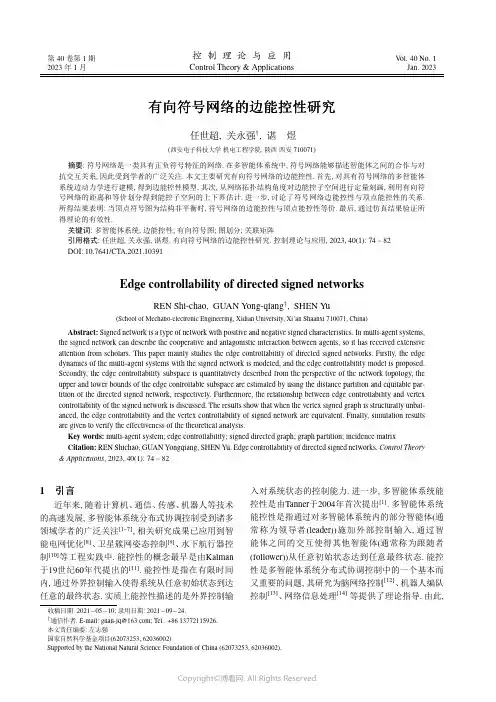
第40卷第1期2023年1月控制理论与应用Control Theory&ApplicationsV ol.40No.1Jan.2023有向符号网络的边能控性研究任世超,关永强†,谌煜(西安电子科技大学机电工程学院,陕西西安710071)摘要:符号网络是一类具有正负符号特征的网络.在多智能体系统中,符号网络能够描述智能体之间的合作与对抗交互关系,因此受到学者的广泛关注.本文主要研究有向符号网络的边能控性.首先,对具有符号网络的多智能体系统边动力学进行建模,得到边能控性模型.其次,从网络拓扑结构角度对边能控子空间进行定量刻画,利用有向符号网络的距离和等价划分得到能控子空间的上下界估计.进一步,讨论了符号网络边能控性与顶点能控性的关系.所得结果表明:当顶点符号图为结构非平衡时,符号网络的边能控性与顶点能控性等价.最后,通过仿真结果验证所得理论的有效性.关键词:多智能体系统;边能控性;有向符号图;图划分;关联矩阵引用格式:任世超,关永强,谌煜.有向符号网络的边能控性研究.控制理论与应用,2023,40(1):74–82DOI:10.7641/CTA.2021.10391Edge controllability of directed signed networksREN Shi-chao,GUAN Yong-qiang†,SHEN Yu(School of Mechano-electronic Engineering,Xidian University,Xi’an Shaanxi710071,China)Abstract:Signed network is a type of network with positive and negative signed characteristics.In multi-agent systems, the signed network can describe the cooperative and antagonistic interaction between agents,so it has received extensive attention from scholars.This paper mainly studies the edge controllability of directed signed networks.Firstly,the edge dynamics of the multi-agent systems with the signed network is modeled,and the edge controllability model is proposed. Secondly,the edge controllability subspace is quantitatively described from the perspective of the network topology,the upper and lower bounds of the edge controllable subspace are estimated by using the distance partition and equitable par-tition of the directed signed network,respectively.Furthermore,the relationship between edge controllability and vertex controllability of the signed network is discussed.The results show that when the vertex signed graph is structurally unbal-anced,the edge controllability and the vertex controllability of signed network are equivalent.Finally,simulation results are given to verify the effectiveness of the theoretical analysis.Key words:multi-agent system;edge controllability;signed directed graph;graph partition;incidence matrixCitation:REN Shichao,GUAN Yongqiang,SHEN Yu.Edge controllability of directed signed networks.Control Theory &Applications,2023,40(1):74–821引言近年来,随着计算机、通信、传感、机器人等技术的高速发展,多智能体系统分布式协调控制受到诸多领域学者的广泛关注[1–7],相关研究成果已应用到智能电网优化[8]、卫星簇网姿态控制[9]、水下航行器控制[10]等工程实践中.能控性的概念最早是由Kalman 于19世纪60年代提出的[11].能控性是指在有限时间内,通过外界控制输入使得系统从任意初始状态到达任意的最终状态.实质上能控性描述的是外界控制输入对系统状态的控制能力.进一步,多智能体系统能控性是由Tanner于2004年首次提出[1].多智能体系统能控性是指通过对多智能体系统内的部分智能体(通常称为领导者(leader))施加外部控制输入,通过智能体之间的交互使得其他智能体(通常称为跟随者(follower))从任意初始状态达到任意最终状态.能控性是多智能体系统分布式协调控制中的一个基本而又重要的问题,其研究为脑网络控制[12]、机器人编队控制[13]、网络信息处理[14]等提供了理论指导.由此,收稿日期:2021−05−10;录用日期:2021−09−24.†通信作者.E-mail:***************;Tel.:+86137****5926.本文责任编委:左志强.国家自然科学基金项目(62073253,62036002).Supported by the National Natural Science Foundation of China(62073253,62036002).第1期任世超等:有向符号网络的边能控性研究75越来越多的研究学者开始关注多智能体系统能控性问题.文献[1,5,7]针对不同的多智能体系统,通过分析系统矩阵的特征值与特征向量得到能控的代数判据.需要指出,代数判据并不直观,且计算复杂度较大,实际应用并不方便.为此,部分学者采用图论工具研究多智能体系统网络拓扑结构与能控性之间的关系,从而获得能控性的图论判据.文献[15–16]基于距离划分研究了多智能体系统能控子空间的下界;文献[16–18]基于等价划分、几乎等价划分研究能控子空间的上界.值得注意的是,以上研究都是针对无符号网络,即,多智能体之间均是合作交互.然而,在现实世界中,对抗交互是普遍存在的,如社交网络中的竞争关系[19]、信息领域中用户对某些信息的不信任态度[20]、生物领域中神经元之间的抑制关系[21].因此,许多学者对符号网络下的多智能体系统分布式协调控制进行了深入研究[22–25].文献[22]研究了符号网络下多智能体系统的二分一致性问题,即在结构平衡图下达成一致的智能体收敛到一个绝对值相同的非零共同值;文献[23]通过分析有向符号图的拉普拉斯矩阵,得到结论:如果有向符号图包含生成树,则所有智能体达到区间二部一致性;文献[24]基于广义几乎等价划分得到对抗交互下多智能体系统能控子空间的上界,进一步给出了求解能控子空间上界的算法;文献[25]研究了具有有向加权符号网络的多智能体系统的能控性,结果表明:结构平衡网络的能控性与无符号网络的能控性等价.上述研究均是针对具有顶点动力学的多智能体系统,即网络中的每个顶点具有一个动力学方程.然而,以边动力学为研究对象的多智能体系统同样具有十分重要的研究意义[26–30].例如,在研究城市交通流量控制问题中,以每一条道路(交通网络中的边)的流量动态建立的交通流量控制模型比基于每个交通路口(交通网络中的顶点)的流量动态建立的模型更加符合实际[26];在研究社交网络团队协作效率问题中,以每对成员之间的沟通频率(社交网络中的边)建立的团队协作模型比基于团队中成员(社交网络中的顶点)的团队协作模型更加符合实际[27].文献[28]刻画了具有合作和对抗相互作用的符号网络的边动力学,并解决了由此产生的边系统的状态收敛问题,进一步作者证明了对于一个符号网络,无论其关联的符号有向图是结构平衡的还是结构非平衡的,其边系统的状态都收敛到一个常数向量;文献[29]基于网络的边动态研究了无向图的非负边一致性问题,并构造了相应的分布式算法.文献[30]基于SBD(switchboard dynamics)模型研究了具有边动力学的有向复杂网络的结构能控性.截至目前,有向符号网络下具有边动力学的多智能体系统能控性尚未有学者研究.本文研究具有有向符号网络的多智能体系统边能控性问题.首先,在符号网络下建立具有边动力学的能控性模型,并通过分析边拉普拉斯矩阵得到边能控性的基本性质;其次,定量刻画边系统能控子空间的大小,特别地,基于距离划分得到能控子空间的下界,基于等价划分得到能控子空间的上界,并且所得的上下界具有紧性(tight);最后,基于符号网络的关联矩阵,给出了边能控性与顶点能控性的关系.结果表明:二者之间的关系取决于顶点图的结构平衡性,特别地,当顶点图是结构非平衡时,边图能控性与顶点图能控性等价.本文研究内容安排如下:第2节介绍图论的相关概念;第3节对边能控性问题进行描述;第4节对边系统能控性进行分析;第5节给出仿真实例;第6节对本文的研究进行总结.符号说明:在本文中,R与C分别表示实数域与复数域.I n={1,2,···,n}表示从1到n的整数集合.对于a∈R,令|a|与sgn a分别表示a的绝对值与符号,其中a可以是一条边、一个实数或者一条路径.I n表示n×n的单位矩阵,rank(A)表示矩阵A的秩,im(A)表示矩阵A的列空间,[A]i,·表示矩阵A的第i行,[A]ij 表示矩阵A第i行第j列的元素.对于任给两个集合S, R(S⊂R),用R\S表示集合S在集合R的补集,|S|表示集合S中的元素个数.2预备知识一个有向符号图由顶点集V={v1,v2,···,v n},边集E={e1,e2,···,e m}⊆V×V构成,记为G=(V, E,A),其中A=[a ij]∈R n×n表示邻接矩阵,具有如下形式:a ij=1或−1,(v j,v i)∈E,0,其他.注1在这里a ij=1表示智能体之间是合作关系,a ij =−1表示智能体之间是对抗关系.如果顶点v i可以接收到顶点v j的信息,则称v j是v i 的入–邻居,v i是v j的出–邻居,v j是边(v j,v i)的起始顶点,v i是边(v j,v i)的终止顶点,(v j,v i)∈E.N in i= {v j∈V|(v j,v i)∈E}表示顶点v i的所有入–邻居的集合.本文研究的图G均为简单图,即不包含自环与多重边.P=(v i,(v i,v i1),v i1,···,(v iq−1,v iq),v iq)表示一个长度为q的路径,其中(v ik,v ik+1)∈E,k=0,1,···,q−1.用d ij表示v i到v j的最短路径(即v i到v j之间最少边的数目).特别地,d ii=0.diam(G)=maxijd ij 表示图G的直径.π={C1,C2,···,C q}表示图G的一个划分,当i=j,i,j∈I q时满足q∪k=1C k=V且C i∩C j=∅.定义1将图G的所有有向边替换为无向边,所76控制理论与应用第40卷得到的无向图G′称为G的基图.如果基图G′是连通的,即G′中的任意两个顶点之间都存在路径,则称有向图G是弱连通的.定义2[22]给定符号图G.对于两个集合V1和V2,V1∩V2=∅且V1∪V2=V,使得∀v i,v j∈V s,(s∈{1,2}),有a ij 0成立;∀v i∈V s,v j∈V t,s=t(s,t∈{1,2}),有a ij 0成立,那么称符号图G是结构平衡的;否则称图G是结构非平衡的.引理1考虑具有n个顶点m条边的弱连通图G,如果满足m=n−1,那么G是结构平衡的.证当m=n−1时,图G的基图G′是一棵生成树,而生成树总是结构平衡的(参看文献[22]),因此G′是结构平衡的.进一步,由结构平衡的定义可知,G′中的顶点能被分成两个集合,而这两个集合的划分对G也适用,并不受边方向的影响.因此,结构平衡性并不改变,即G也是结构平衡的.证毕.值得注意的是本文所述的顶点图与边图本质上都是有向符号图.为了表述方便,分别采用G v与G e进行标记.2.1顶点符号图考虑一个具有n个顶点m条边的顶点图G v.定义G v的拉普拉斯矩阵为L v=C v−A v,其中:C v=diag{n ∑j=1|a1j|,n∑j=1|a2j|,···,n∑j=1|a nj|}表示G v的入度矩阵,A v表示G v的邻接矩阵.定义3G v的关联矩阵H=[h qk]∈R n×m是一个仅包含{0,±1}的矩阵.具体来说,任取一条边e k,相关联的两个顶点为v q与v s,那么∀q,s∈I n,k∈I m满足h qk=1,如果v q是e k的起点;−a qs,如果v q是e k的终点; 0,其他.为了区别一个顶点的入边与出边,引入入–关联矩阵与出–关联矩阵的定义.定义4给定G v及任一条边e k,相关联的两个顶点为v q与v s,入–关联矩阵H in=[h in qk]∈R n×m描述为:∀q,s∈I n,k∈I m有h in qk =−a qs,如果v q是e k的终点;0,其他.出–关联矩阵H out=[h out qk]∈R n×m描述为:∀q,s ∈I n,k∈I m有h out qk =1,如果v q是e k的起点;0,其他.由定义3和定义4显然有H=H in+H out.引理2[31]令H∈R n×m表示G v的关联矩阵,那么有以下结果成立:rank(H)=n−1,G v是结构平衡的;n,G v是结构非平衡的.2.2符号边图给定一个图G v,G e=(V e,E e,A e)表示G v对应的边图,其中V e表示边图G e的顶点集,E e表示边图G e中的连接边集,A e表示边图G e的邻接矩阵.取G v中的两条边e h=(v j,v i)和e k=(v s,v q),其中h=k.如果e k指向e h的任一顶点,那么称e k是e h的入–邻居.为了便于理解,给出e h的入–邻居如图1所示.定义N ine h= {e k=(v s,v q):e k∈E,e k=e h且v q=v j或v q= v i}表示e h的入–邻居集合.A e=[¯a hk]∈R m×m满足:如果e h∈N in e k,有[¯a hk]∈{1,−1};否则[¯a hk]=0,即¯a hk=−a qs,e k∈N in eh且v q=v j;a qs a ij,e k∈N in e h且v q=v i;0,其他.图1e h的入–邻居的两种情况Fig.1Two cases of in-neighbors of edge e h 定义5给定一个具有n个顶点m条边的顶点图G v,G v对应的边图G e的拉普拉斯矩阵定义为L e=I m+A e.(1)引理3[28]给定一个顶点图G v,对应的边图为G e,H与H in分别表示G v的关联矩阵与入–关联矩阵,则顶点拉普拉斯矩阵L v∈R n×n与边拉普拉斯矩阵L e∈R m×m分别满足L v=H in H T,(2)L e=H T H in.(3)基于引理3有H T L v=L e H T成立.3问题描述考虑一个具有n个顶点m条连接关系的多智能体系统.假设边集V e被分为领导者集合V e l以及跟随者集合V e f,其中V e l∪V e f=V e,V e l∩V e f=∅.不失一般性,假设前p(p<m)条边选作为领导者,即V e l={e1, e2,···,e p},那么跟随者集合为V e f={e p+1,e p+2,···,e m}.定义6给定边图G e,如果对于每一个跟随者都至少有一条从某一个领导者出发的路径,那么称图G e 是领导者–跟随者(leader-follower)连通的.第1期任世超等:有向符号网络的边能控性研究77注2本文中考虑的图均为领导者–跟随者连通的.在领导者–跟随者框架下,边e i的动力学方程为˙x i(t)=−x i(t)−m∑j=1¯a ij x j(t)+u i(t),i∈V e l,˙x i(t)=−x i(t)−m∑j=1¯a ij x j(t),i∈V e f,(4)其中:x i(t)∈R表示边e i的状态,u i(t)表示作用在第i 条边上的外界控制输入.令x(t)=[x1(t)x2(t)···x m(t)]T∈R m,u(t) =[u1(t)u2(t)···u p(t)]T∈R p.整个多智能体系统的演化边动力学方程为˙x(t)=−L e x(t)+Bu(t).(5)其中:L e∈R m×m是边拉普拉斯矩阵,B=[I p0]T∈R m×p是控制输入矩阵.系统(5)可采用矩阵对(−L e, B)表示.定义7如果存在一个控制输入u(t)能在有限时间t1−t0(t1>t0)内使得系统(5)由任意初始状态x(t0)能够到达任意最终状态x(t1),则称系统(5)是能控的.定义矩阵Q=[B L e B···L m−1eB]和矩阵¯Q=[B A e B···A m−1eB]分别表示系统(5)以及矩阵对(A e,B)的能控性矩阵.定理1系统(5)的能控性等价于矩阵对(A e,B)的能控性,即rank(Q)=rank(¯Q).证首先,系统(5)的能控性矩阵Q可写成如下形式:Q=[B,L e B,···,L m−1eB]=[B,(I m+A e)B,···,(I m+A e)m−1B]=[B,B+A e B,···,B+(m−1)A e B+···+A m−1eB].显然存在一个可逆矩阵K∈R mp×mp(在矩阵Q 上经过多次列变换所得),使得¯Q=Q K.因此,rank(Q) =rank(¯Q),表明系统(5)的能控性等价于矩阵对(A e, B)的能控性.证毕.4边能控性分析在本节中,从图论的角度对系统(5)的能控性进行分析.特别地,基于符号边图的距离划分得到能控子空间的下界,基于符号边图的等价划分得到能控子空间的上界.进一步,分析了边能控性与顶点能控性的关系.4.1边能控子空间下界给定边图G e.用P ei→e j,d =(e i,ℓ1,e i+1,ℓ2,···,ℓd,e j)表示从e i到e j长度为d的一条路径,其中e i∈V e,ℓd∈E e.考虑路径P e i→e j,d的符号sgn(P ei→e j,d)=∏ℓd∈P e i→e j,dsgn(ℓd).(6)考虑路径P ei→e j,d的权重ω(P ei→e j,d)ω(P ei→e j,d)=∏ℓd∈P e i→e j,dω(ℓd),(7)其中ω(ℓd)表示边ℓd的权值.不难发现,从e i到e j的路径可能不唯一,因此sgn(P ei→e j,d)可能也不唯一.如果sgn(P ei→e j,d)=1,称该路径为正路;如果sgn(P ei→e j,d)=−1,称该路径为负路.注3本文所考虑的边图G e的权重值¯a ij∈{±1,0},因此|sgn(P ei→e j,d)|=|ω(P ei→e j,d)|.考虑sgn(P ei→e j,d)=1的所有路径的总权重为ρ+e i→e j,d=∑P ei→e j,d∈Γ+e i→e j,dω(P ei→e j,d),(8)其中Γ+e i→e j,d表示sgn(P ei→e j,d)=1的所有路径.考虑sgn(P ei→e j,d)=−1的所有路径的总权重ρ−e i→e j,d=∑P ei→e j,d∈Γ−e i→e j,dω(P ei→e j,d),(9)其中Γ−e i→e j,d表示sgn(P ei→e j,d)=−1的所有路径.因此,从e i到e j长度为d的所有路径的总权重为ρei→e j,d=ρ+e i→e j,d+ρ−e i→e j,d.(10)特别地,当|sgn(P ei→e j,d)=1|=|sgn(P ei→e j,d) =−1|时,有ρei→e j,d=0.引理4给定边图G e,则如下等式成立:[A de]ji=ρei→e j,d,(11)其中d表示e i到e j的长度.证采用对d的数学归纳法进行证明.首先,当d=1时,从e i到e j有长度为1的路径当且仅当¯a ji=±1;其次,假设[A d−1e]ji=ρei→e j,d−1成立;最后,对于[A de]ji有[A de]ji=[A e A d−1e]ji=m∑r=1[A e]jr[A d−1e]ri=m∑r=1[A e]jrρei→e r,d−1=ρei→e j,d.综上所述,等式(11)成立.证毕.考虑边图G e,用πD(e i)={C0,C1,···,C q}表示关于e i的距离划分(distance partition).其中Cκ={e k∈V e|d ik=κ}.如果∀e j∈Cκ都有ρe i→e j,κ=0,那么记ρei→Cκ,κ=0,其中1 κ diam(G e).令z C={κ|ρei→Cκ,κ=0},δei=|πD(e i)|−|z C|.定理2系统(5)的能控性矩阵Q满足rank(Q) max{δe1,δe2,···,δep}.(12)78控制理论与应用第40卷证首先考虑单领导者的情况.不失一般性,假设e1为领导者,令πD(e1)={C0,C1,···,C q}为相对于e1的距离划分,其中q diam(G e),那么C0={e1},Cκ={e iκ+1,e iκ+2,···,e iκ+1},1 κ diam(G e).即V e l={e1},给定e i=e1,则[A d1ie B]i1=n∑r=1[A d1ie]ir[B]r1=[A d1ie]i1B=[A d1ie]i1.因此,当[A e]d1i i1=0,有[A d1i e B]i1=0;否则[A d1i e B]i1 =0.给定一个整数κ,其中1 κ diam(G e).当κ<d1i,不难发现[AκeB]i1=0.构造矩阵M∈R m×diam(G e)M=[B A e B···Aκe B···A diam(G e)e B]=1∗···∗···∗0M1···*···*............ 00···Mκ···*............00···0···M diam(Ge),其中Mκ=[ρe1→e iκ+1,κρe1→e iκ+2,κ···ρe1→eκ+1,κ]T∈R|Cκ|,1<i r |Cκ|.显然M表示能控性矩阵¯Q的一个子矩阵.接下来,分两种情况来讨论rank(M):1)如果ρe1→Cκ,κ=0,∀1 κ diam(G e),可得rank(M) diam(G e)=|πD(e1)|=δe1;2)如果ρe1→Cκ,κ=0,∃1<κ diam(G e),可得rank(M) |πD(e1)|−|z C|=δe1.综上所述,rank(Q)=rank(¯Q) rank(M) δe1.在多领导者的情况下,针对每个领导者单独分析,按照单领导者的情况易得rank(Q)=rank(¯Q)max{δe1,δe2,···,δep}.证毕.注4定理2所得到的下界是紧的.事实上,可以构造一些边图使得下界成立.例1给定一个如图2所示的边图G e.在此假设e1是唯一的领导者,基于距离划分有πD(e1)={C0, C1,C2,C3}={{e1},{e2},{e3,e4},{e5}}.对于C3={e5}来说,有两条从e1到e5长度为3的路径P1e1→e5,3=(e1,(e1,e2),e2,(e2,e3),e3,(e3,e5),e5)和P2e1→e5,3=(e1,(e1,e2),e2,(e2,e4),e4,(e4,e5),e5),其中(e i,e j)∈E e.不难发现P1e1→e5,3是一条正路,P2e1→e5,3是一条负路,因此有ρe1→C3,3=0,z C={3},|z C|=1且δe1=3,通过计算能控性矩阵Q,有rank(Q)=δe1=3.图2有向符号边图G e.实线和虚线分别表示正边与负边Fig.2Signed edge graph G e.The solid and the dashed lines represent the positive and negative edges,respectively同理,当选择e1和e2作为领导者时,有πD(e2)= {C0,C1,C2}={{e2},{e3,e4},{e5}},z C={2}且δe2=2.通过计算能控性矩阵Q,可得rank(Q)= max{δe1,δe2}=3.4.2边能控子空间上界令π={C1,C2,···,C q}是边图G e的一个划分,定义βij=∑e k∈C i∑e g∈C j¯a kg|C i|,i,j∈I q,βij表示在划分π下C j到C i中的度.用G e/π=(Vπ,Eπ, Bπ)表示边图G e在划分π下的商图,其中Vπ={C1, C2,···,C q}表示商图G e/π顶点集,Eπ={(C j,C i)|βij =0}表示商图G e/π边集,[Bπ]ij=βij表示商图G e/π邻接矩阵第i行第j列的元素.对于给定的划分π的特征矩阵定义为Pπ=[p ij]∈R m×q,若e i∈C j,则p ij= 1;否则p ij=0.定义8令π={C1,C2,···,C q}是边图G e的一个划分,如果划分π下有如下等式成立:∑e s∈C i¯a ks=∑e g∈C i¯a tg,∀e k,e t∈C j,(13)则称π是一个等价划分(equitable partition).引理5π={C1,C2,···,C q}是边图G e的一个等价划分当且仅当A e Pπ=PπBπ,即im(Pπ)是A e的不变子空间.证充分性:不失一般性,假设e k∈C j.如果A e Pπ=PπBπ,有[A e Pπ]kj=m∑r=1[A e]kr[Pπ]rj=m∑r=1¯a kr[Pπ]rj=∑e s∈C j¯a ks.由于[P Bπ]k,·=[Bπ]j,·,那么对于e t∈C j有[A e P]kj=[A e P]tj,即∑e s∈C i¯a ks=∑e g∈C i¯a tg,e k,e t∈C j.因此π是一个等价划分.必要性:假设π是一个等价划分,令e k∈C j,进而A e Pπ的第k行可以表示为[A e Pπ]k,·=[∑e t∈C1¯a kt···∑e t∈C j−1¯a kt∑e t∈C j¯a kt···∑e t∈C q¯a kt]= [βj1···βj(j−1)βjj···βjq].由特征矩阵Pπ的定义可得,PπBπ的第k行可以表示为[PπBπ]k,·=[Bπ]j,·=第1期任世超等:有向符号网络的边能控性研究79[βj 1···βj (j −1)βjj ···βjq ],因此,A e P π=P πB π是成立的.证毕.定义9给定一个等价划分π,如果选取的每个领导者都单独在一个胞腔中,则称π为领导者孤立的等价划分(leader-isolated equitable partition,LEP),简记为πLEP .引理6假设πLEP 是边图G e 的一个领导者孤立的等价划分,则系统(5)的能控性矩阵Q 满足rank(Q ) |πLEP |.(14)证令P πLEP 表示πLEP 的特征矩阵,不难得到im(B )⊆im(P πLEP ).进一步地,结合式(11)可得im(Q )=im(¯Q)=im([B A e B ···A m −1eB ])=im(B )+A e im(B )+···+A m −1eim(B )⊆im(P πLEP )+···+A m −1eim(P πLEP )=im(P πLEP ),这里运算符“+”表示两个空间的并.证毕.值得注意的是,一个边图G e 的领导者孤立的等价划分可能不唯一.假设πLEP1,πLEP2是边图G e 的两个不同的领导者孤立的等价划分,如果对于每一个在πLEP1的胞腔是πLEP2中一些胞腔的子集,那么称πLEP1比πLEP2更好(finer),用πLEP1 πLEP2来表示.如果πLEP1 πLEP2,易得im(P πLEP2)⊆im(P πLEP1).因此在寻找能控子空间的上界时,要求去找到一个最好的领导者孤立的等价划分,简记为π∗LEP .定理3假设π∗LEP 是边图G e 的最好领导者孤立的等价划分,那么系统(5)的能控性矩阵Q 满足rank(Q ) |π∗LEP |.(15)例2给定如图3中左图所示的边图G e .假设e 1作为领导者,可以得出π∗LEP ={{e 1},{e 2,e 3,e 4},{e 5,e 6,e 7}}.通过计算易得A e P π∗LEP =P π∗LEP B π∗LEP .进一步有rank(Q )=|π∗LEP|=3成立.图3边图G e (左)与其商图G e /π∗LEP(右).Fig.3Edge graph G e (left)and quotient graph G e /π∗LEP(right).The solid line and the dashed lines represent the positive and negative edges,respectively4.3边能控性与顶点能控性本节研究顶点能控性与边能控性之间的关系.首先引入顶点能控性模型.考虑一个具有n 个顶点m 条边的顶点图G v ,假设前p (p <n )个顶点作为领导者集V l ={v 1,v 2,···,v p },那么剩余的顶点集即为跟随者集V f =V\V l .令u (t )表示对顶点施加的控制量,每一个智能体服从以下的动态方程: ˙x i v (t )=n ∑j =1a ij [x j v (t )−sgn(a ij )x iv (t )]+u i (t ),i ∈V l ,˙x i v (t )=n ∑j =1a ij [x j v (t )−sgn(a ij )x i v (t )],i ∈V f ,其中:x i v (t )∈R 表示第i 个智能体的状态,u i (t )表示对智能体i 施加外部的控制输入.令x v (t )=[x 1v (t )x 2v (t )···x n v (t )],u (t )=[u 1(t )u 2(t )···u p (t )].整个多智能体系统的顶点动力学方程为˙x v (t )=−L v x v (t )+˜Bu(t ),(16)其中:L v ∈R n ×n ,˜B=[I p 0]T ∈R n ×p 表示控制输入矩阵.考虑顶点图G v 中的一条边e k =(v j ,v i ),定义边e k 的状态为x k (t )=x j v (t )−a ij x iv (t ).(17)从式(17)得所有边的状态可以表达为x (t )=H T x v (t ).因此,基于式(17)边系统模型可以描述为˙x (t )=−L e x (t )+¯Bu(t ),(18)其中¯B=H T ˜B ∈R m ×p .注5系统(16)的控制输入是一个独立控制输入(如图4中左图所示),即˜B=[e 1e 2···e p ]∈R n ×p ,其中e i 表示I n 的第i 列;系统(18)的控制输入为广播控制输入(如图4中右图所示),即¯B =[b 1b 2···b p ]∈R m ×p ,其中b k ∈{−1,0,1}m ,k ∈I p.图4独立控制输入(左)和广播控制输入(右)Fig.4Independent control input (left)and broadcastcontrol input (right)定义如下3个矩阵:Q v :=[˜B L v ˜B ···L n −1v ˜B ]∈R n ×np ,Q e :=[¯B L e ¯B ···L m −1e¯B ]∈R m ×mp ,Q ′:=[˜B L v ˜B ···L m −1v˜B ]∈R n ×mp ,(19)其中:Q v 表示系统(16)的能控性矩阵;Q e 表示系统(18)的能控性矩阵.根据引理3不难得出Q e =H T Q ′.80控制理论与应用第40卷定理4假设一个具有n 个顶点m 条边的顶点图G v ,边状态服从式(17).以下结果成立:1)如果G v 是结构平衡的,则有rank(Q e ) rank(Q v ).2)如果G v 是结构非平衡的,则有rank(Q e )=rank(Q v ).证显然,对于一个领导者–跟随者连通的顶点图G v ,有m n −1.1)顶点图G v 是结构平衡时,由引理2可得rank(H T )=n −1,当m =n −1时,有rank(Q ′) rank(Q v )成立;当m >n −1时,rank(Q ′)=rank(Q v )成立.因此可得rank(Q e ) min {rank(H T),rank(Q ′)}=min {n −1,rank(Q ′)} rank(Q ′) rank(Q v ).2)顶点图G v 是结构非平衡时,由引理1可知m >n −1,rank(Q ′)=rank(Q v )成立.进一步,由引理2可得rank(H T )=n .因此rank(Q e )=rank(H T Q ′)=rank(Q ′)=rank(Q v ).证毕.例3给定如图5(a)所示的结构平衡顶点图G v 1.假设v 1作为单独的领导者,即˜B=[1000]T .根据式(17)得¯B=[100]T .通过计算可得rank(Q e )=rank(Q v )=3成立.同理,给定如图5(c)所示的结构非平衡顶点顶点图G v 2,仍然假设v 1作为单独的领导者,有rank(Q e )=rank(Q v )=4.(a)结构平衡顶点图G v1(b)G v 1对应的边图G e1(c)结构非平衡顶点图G v2(d)G v 2对应的边图G e 2图5数值例子.实线和虚线分别表示正边与负边Fig.5Numerical example.The solid and the dashed linesrepresent the positive and negative edges,respectively推论1假设顶点图G v 对应的系统(16)是能控的,则1)如果G v 是结构平衡的,那么rank(Q e )=n −1.2)如果G v 是结构非平衡的,那么rank(Q e )=n .例4给定如图6(a)所示的结构平衡顶点图G v 1.假设v 1作为单独的领导者,即˜B=[1000]T .根据式(17)得¯B=[1000]T .通过计算可得rank(Q v )=4,rank(Q e )=3.同理,给定如图6(c)所示的结构非平衡顶点图G v 2,仍然假设v 1作为单独的领导者,有rank(Q e )=rank(Q v )=4.(a)结构平衡顶点图G v1(b)G v 1对应的边图G e1(c)结构非平衡顶点图G v2(d)G v 2对应的边图G e 2图6数值例子.实线和虚线分别表示正边与负边Fig.6Numerical example.The solid and the dashed linesrepresent the positive and negative edges,respectively5仿真实例为了验证本文所得到的理论结果,考虑由4个智能体构成的顶点图G v ,如图7中左图所示.G e 表示G v 对应的边图,如图7中右图所示.给出G e 的拉普拉斯矩阵L e = 100−1110−10−110−10−11.图7有向符号顶点图G v (左)与其对应的边图G e (右).实线和虚线分别表示正边与负边Fig.7Directed signed vertex graph G v (left)and its corre-sponding edge graph G e (right).The solid and dashed lines represent the positive and negative edges,re-spectively假设e 4作为领导者,即B =[0001]T ,通过计算可得rank(Q )=4,表明系统(5)是能控的.为了更加直观的理解,给定边初始状态x (t 0)=[0000]T ,边最终状态x (t f )=[−5101010]T ,在有限时间t f =第1期任世超等:有向符号网络的边能控性研究8110内边状态的变化曲线如图8所示,控制输入的变化曲线如图9所示.U1086420−50−40−30−20−101020䗩⣦ Y J J 1, 2, 3, 4图8边状态曲线Fig.8Curves of edgestateU1086420−80−60−40−202040 䗃 V (U )图9控制输入曲线u (t )Fig.9Curve of control input u (t )6结论与展望本文基于领导者–跟随者结构研究了有向符号网络下多智能体系统边能控性问题.首先,在符号网络下建立具有边动力学能控性模型,通过分析边拉普拉斯矩阵得到边能控性的一些性质;其次,从图论的角度对边能控性子空间进行定量分析.特别地,基于距离划分给出了边能控子空间的下界以及基于等价划分给出了边能控子空间的上界,并且得到的上下界具有紧性.最后,基于图的关联矩阵研究了顶点图能控性与对应边图能控性之间的关系,得出当顶点图为结构非平衡时,顶点图的能控性等价于对应边图的能控性.本文考虑了固定拓扑结构的情形,未来将进一步考虑动态拓扑结构下的边能控性.此外,文本考虑的边权取值范围是{0,±1},当系统的权重为任意取值时,同样是一个值得研究的问题.参考文献:[1]TANNER H G.On the controllability of nearest neighbor intercon-nections.Proceedings of the 43th IEEE Conference on Decision andControl .Paradise Island,the Bahamas:Springer,2004,3:2467–2472.[2]LI A,CORNELIUE S P,LIU Y ,et al.The fundamental advantages oftemporal networks.Science ,2017,358(6366):1042–1046.[3]GUAN Y ,LI A,WANG L.Structural controllability of directedsigned networks.IEEE Transactions on Control of Network Systems ,2021,DOI:10.1109/TCNS.2021.3059836.[4]GUAN Yongqiang,JI Zhijian,ZHANG Lin,et al.Recent develop-ments on controllability of multi-agent systems.Control Theory &Applications ,2015,32(4):421–431.(关永强,纪志坚,张霖,等.多智能体系统能控性研究进展.控制理论与应用,2015,32(4):421–431.)[5]JI Z,WANG Z,LIN H,et al.Interconnection topologies for multi-agent coordination under leader-follower framework.Automatica ,2009,12(45):2857–2863.[6]CHEN Shiming,WANG Pei,LI Haiying,et al.Controllable con-tainment control of multi-agent systems with strongly connected sub-graph.Control Theory &Applications ,2017,34(3):401–407.(陈世明,王培,李海英,等.带强连通分支的多智能体系统可控包含控制.控制理论与应用,2017,34(3):401–407.)[7]LIU S,JI Z,MA H.Jordan form-based algebraic conditions for con-trollability of multi-agent systems under directed plexity ,2020,7685460:1–18.[8]FIORETTO F,DOVIER A,PONTELLI E.Distributed multi-agentoptimization for smart grids and home automation.Intelligenza Arti-ficiale ,2019,12(2):67–87.[9]DO K D.Formation control of underactuated ships with ellipticalshape approximation and limited communication ranges.Automati-ca ,2012,485(7):1380–1388.[10]WANG Yintao,YAN Weisheng.Consensus formation tracking con-trol of multiple autonomous underwater vehicle systems.Control Theory &Applications ,2013,30(3):379–384.(王银涛,严卫生.多自主水下航行器系统一致性编队跟踪控制.控制理论与应用,2013,30(3):379–384.)[11]KALMAN R E,HO Y C.Controllability of linear dynamical systems.Contributions to Differential Equations ,1963,1(2):189–213.[12]GU S,PASQUALETTI F,CIESLAK M,et al.Controllability ofstructural brain networks.Nature Communications ,2015,6(1):1–10.[13]LAFFERRERE G,WILLIAMS A,CAUGHMAN J,et al.Decentral-ized control of vehicle formations.Systems &Control Letters ,2005,54(9):899–910.[14]DECKE K S,SYCARA K.Intelligent adaptive information agents.Journal of Intelligent Information Systems ,1997,9(3):239–260.[15]YAZICIO ˇGLU A Y ,ABBAS W,EGERSTEDT M.Graph distancesand controllability of networks.IEEE Transactions on Automatic Control ,2016,61(12):4125–4130.[16]ZHANG S,CAO M,CAMLIBEL M K.Upper and lower bounds forcontrollable subspaces of networks of networks of diffusively cou-pled agents.IEEE Transactions on Automatic Control ,2014,59(3):745–750.[17]RAHMANI A,JI M,MESBAHI M,et al.Controllability of multi-agent systems from a graph-theoretic perspective.SIAM Journal on Control and Optimization ,2009,48(1):162–186.[18]ZHANG Anhui,ZHANG Shijie,CHEN Jian,et al.Graph-theoreticcharacterization of controllability for multi-agent systems.Control and Decision ,2011,26(11):1621–1626,1631.(张安慧,张世杰,陈健,等.多智能体系统能控性的图论刻画.控制与决策,2011,26(11):1621–1626,1631.)[19]HEIDER F.Attitudes and cognitive organization.Journal of Psychol-ogy ,1946,21(1):107–112.82控制理论与应用第40卷[20]GUHA R,KUMAR R,RAGHA V AN P,et al.Propagation of trust anddistrust.Proceedings of the13th International Conference on World Wide Web.New York,USA:ACM,2004:403–412.[21]PARISIEN C,ANDERSON C H,ELIASMITH C.Solving the prob-lem of negative synaptic weights in cortical models.Neural Compu-tation,2008,20(6):1473–1494.[22]ALTAFINI C.Consensus problems on networks with antagonistic in-teractions.IEEE Transactions on Automatic Control,2013,58(4): 935–946.[23]MENG D,DU M,JIA Y.Interval bipartite consensus of networkedagents associated with signed digraphs.IEEE Transactions on Auto-matic Control,2016,61(12):3755–3770.[24]SUN C,HU G,XIE L.Controllability of multi-agent networks withantagonistic interactions.IEEE Transactions on Automatic Control, 2017,62(10):5457–5462.[25]GUAN Y,WANG L.Controllability of multi-agent systems with di-rected and weighted signed networks.Systems&Control Letters, 2018,116:47–55.[26]GRANDINETTI P,CANUDAS-DE-WIT C,GARIN F.Distributedoptimal traffic lights design for large-scale urban networks.IEEE Transactions on Control Systems Technology,2018,27(3):950–963.[27]PENTLAND A S.The new science of building great teams.HarvardBusiness Review,2012,90(4):60–69.[28]DU M,MA B,MENG D.Edge convergence problems on signednetworks.IEEE Transactions on Cybernectics,2019,49(11):4029–4041.[29]WANG X,SU H,CHEN M,et al.Reaching non-negative edge con-sensus of networked dynamical systems.IEEE Transactions on Cy-bernetics,2018,48(9):2712–2722.[30]NEPUSZ T,VICSEK T.Controlling edge dynamics in complex net-works.Nature Physics,2012,8(7):568–573.[31]BELARDO F,SIMI´C S K.On the Laplacian coefficients of signedgraphs.Linear Algebra and Its Applications,2015,475:94–113.作者简介:任世超硕士研究生,主要研究方向为多智能体系统能控性, E-mail:*****************;关永强副教授,主要研究方向为多智能体系统分布式协同控制, E-mail:***************;谌煜硕士研究生,主要研究方向为多智能体系统能控性,E-mail:******************.。
领航跟随型编队(七)leader-follower实现⾓度不变的直线编队%初始化leader 状态;leader.w=0.6;leader.v=0.75;leader.theta=0;%leader 的航向⾓;% leader.beta=pi/6;%两个车的中⼼线与其中之⼀的连线,相当于⽅位⾓leader.x=4.0;leader.y=9.0;%初始化follower1的速度位姿follower1.x=3;follower1.y=8;follower1.theta=0;follower1_ideal.beta=pi/6;follower1.v=1.0;follower1.beta(1)=pi/6;follower1.w=0.6%初始化follower2 的位姿follower2.x=3;follower2.y=10;follower2.theta=0;follower2_ideal.beta=pi/6;follower2.beta(1)=pi/6;follower2.v=1.0;%初始化队形参数即增益系数和理想距离和⾓度l21=1.4;c21=1.4;c31=1.4;gama21=pi/3;gama31=pi/3;%编队队形b=0.1315;d=0.15;r=0.095;%车⾝参数K11=1;K12=0.6;K13=0.5;%增益系数df=0.85;%队形的最⼤宽度J=20;for i=1:ts:JStep=Step+1;leader_ideal.w=0.0;leader_ideal.v=1;leader_ideal.theta=0;%leader 的航向⾓;% leader.beta=pi/6;%两个车的中⼼线与其中之⼀的连线,相当于⽅位⾓leader_ideal.x=leader.x+ts*leader.v*cos( leader.theta);%采样周期内⼀步⼀步的计算,leader_ideal.y=leader.y+ts*leader.v*sin( leader.theta);follower1_ideal.theta =leader.theta;follower1_ideal.y = leader.y-c21*sin(gama21+follower1_ideal.theta);follower1_ideal.x =leader.x-c21*cos(gama21+follower1_ideal.theta);follower1_ideal.v=leader.v;follower1_ideal.w= leader.w;follower2_ideal.y = leader.y+c31*sin(gama31+follower2_ideal.theta);follower2_ideal.x =leader.x-c31*cos(gama31+follower2_ideal.theta);follower2_ideal.v=leader.v;follower2_ideal.w= leader.w;%计算follower1d的误差e1(1) =cos(follower1.theta(step))*(follower1_ideal.x(step)-follower1.x(step))+sin(follower1.theta(step))*(follower1_ideal.y(step)-follower1.y(step));e1(2)=-sin(follower1.theta(step))*(follower1_ideal.x(step)-follower1.x(step))+cos(follower1.theta(step))*(follower1_ideal.y(step)-follower1.y(step));e1(3)= follower1_ideal.theta(step) -follower1.theta(step);follower1_xe=e1(1);follower1_ye=e1(2);follower1_thetae=e1(3);follower1.v=follower1_ideal.v*cos(follower1_thetae)+K11*follower1_xe;follower1.w=follower1_ideal.w+K12*follower1_ideal.v*follower1_ye+K13*follower1_ideal.v*sin(follower1_thetae); follower1.theta=follower1.theta+ts*follower1.w;follower1.x=follower1.x+ts*follower1.v*cos( follower1.theta);follower1.y=follower1.y+ts*follower1.v*sin( follower1.theta);plot( follower1.x, follower1.y, 'y.');hold on;e2(1) =cos(follower2.theta(step))*(follower2_ideal.x(step)-follower2.x(step))+sin(follower2.theta(step))*(follower2_ideal.y(step)-follower2.y(step));e2(2)=-sin(follower2.theta(step))*(follower2_ideal.x(step)-follower2.x(step))+cos(follower2.theta(step))*(follower2_ideal.y(step)-follower2.y(step));e2(3)= follower2_ideal.theta(step) -follower2.theta(step);follower2_xe=e2(1);follower2_ye=e2(2);follower2_thetae=e2(3);follower2.v=follower2_ideal.v*cos(follower2_thetae)+K11*follower2_xe;follower2.w=follower2_ideal.w+K12*follower2_ideal.v*follower1_ye+K13*follower2_ideal.v*sin(follower2_thetae);%计算follower2当前的位姿follower2.theta=follower2.theta+ts*follower2.w;follower2.x=follower2.x+ts*follower2.v*cos( follower2.theta);follower2.y=follower2.y+ts*follower2.v*sin( follower2.theta);plot( follower2.x, follower2.y, 'c.');hold on;end%%figure(1);%plot(follower1_xe,follower1_ye,':r');% hold on;plot( leader.x, leader.y, 'r.',follower1.x, follower1.y, 'y.',follower2.x, follower2.y,'c.');hold onGraphicHandle= plot( leader.x, leader.y, 'b.',follower1.x, follower1.y, 'r.', follower2.x,follower2.y,'c.');set( GraphicHandle,'MarkerSize',4);xlabel('x[m]')ylabel('y[m]')title ('trajectory of the robots ')legend('leader','follower1','follower2')figure(2);GraphicHandle= plot( leader.v,'ko');hold on;ylabel(' leader.v[m/s]')xlabel('t[s]')h=title ('velocity of the leader ')set(h,'Fontsize',15);figure(3);GraphicHandle= plot( leader_xe,'ko');hold on;ylabel('leader_xe[m]')xlabel('ts[s]')h=title ('error of the leader ')set(h,'Fontsize',15);end。
多智能体的鲁棒自适应有向三角编队控制朱亚东;杜晋;王芹【摘要】针对一类具有不确定性和外部干扰的三个智能体系统,提出了基于距离的分散自适应有向编队控制策略。
利用模糊系统的逼近能力对单个智能体的不确定动态进行逼近,同时通过参数自适应估计消除了逼近误差和外部干扰对系统的影响;进一步,引入势能函数避免个体之间的碰撞。
通过Babalat引理能够证明所提控制算法能够保证期望的三角队形且每个智能体都能达到期望的速度。
%In this paper, a decentralized adaptive control scheme of directed triangle formation based on interagent distances is worked out for three multi-agent systems with uncertain nonlinear dynamics and external disturbances. Uncertain dynamics terms are approximated by the first type fuzzy systems. At the same time, the effects of approximation error and external disturbances are eliminated by using the adaptive estimation ofpa- rameter. Furthermore, the inter-agent potential functions are introduced to avoid the collision between each a- gent. By the Babalat' s lemma, the proposed control algorithms can not only accomplish the desired formation but also ensure that speeds of all agents converge to a common value during the motion.【期刊名称】《扬州职业大学学报》【年(卷),期】2011(015)002【总页数】5页(P29-33)【关键词】多智能体系统;分散自适应控制;有向编队控制【作者】朱亚东;杜晋;王芹【作者单位】扬州职业大学,江苏扬州225009;扬州职业大学,江苏扬州225009;扬州职业大学,江苏扬州225009【正文语种】中文【中图分类】TP27320世纪90年代后期,多智能体的编队控制研究获得了深入的发展,相关研究成果在协同搜寻、营救、导航和多机器人规划、水下航行器控制及空间航行器的控制方面发挥了很大的作用[1-3]。
自动驾驶中车辆和车路协同的具体技术从自动驾驶的的单车(single agent)智能过渡到车辆/车路协同的多智体(multi-agent)智能,也是车联网和智慧城市/交通的优势,下面列一些供阅读的有关文献。
网联自动车形成了所谓的汽车互联网(IOV),预计最早将在2021年改变世界范围内的交通运输方式,并改变城市生活,并在未来几十年中普及。
网联自动车经常被吹捧为一项在不久的将来将在社会中普及的技术。
人们可以将自动驾驶汽车视为具有人工智能(AI)功能,能够自动驾驶、感知其周围环境、识别其附近的物体并执行推理和决策的功能。
它不是单独运行,而是研究了自动驾驶汽车在其社会网络物理(socio-cyber-physical)环境中进行合作和交互的必要性,包括合作将解决的问题以及议题和挑战。
它根据选定的示例回顾了当前在自动驾驶汽车方面的合作工作。
其结论指出,除了感知直接环境和基础网络技术之外,作为自动驾驶汽车的社交人工智能(social-AI)功能的一种形式,还需要具有协作行动(behave cooperatively)的能力。
车辆需要通过专用短程距离联网(DSRC)或5G-V2X网络,采用IoT服务(包括通过路边单元),不仅与其他车辆而且还可能与摩托车、自行车、行人和其他道路用户进行交互。
通过这样的网络协议,车辆有机会交换应用层消息并进行合作以提高安全性,并提高其有效性,从而在车辆网络层(vehicular network layer)之上创建一个协作层(cooperation layer)。
社交车辆(Social vehicles)构想了CAV的社交大脑(social brain),CAV被定义为一个软件模块,该软件模块确定车辆如何与其他车辆协作、车辆如何与车联网络上的行人和服务协作、车辆如何推理社交行为、车辆在收到特定消息时如何表现,以及在路况下如何利用车辆间的合作。
CAV的社交大脑可以针对道路上的其他车辆和行人推断出社会状况(social situations ),记住过去的互动以为将来的合作提供信息,在道路的社交规范内工作,并具有上下文觉察(context-aware)的关注(类似于人类的社会认知)。
随机拓扑下离散多智能体事件触发一致性作者:赵阳解静曹洒来源:《青岛大学学报(工程技术版)》2024年第01期摘要:針对离散时间多智能体跟踪不稳定的问题,本文研究离散多智能体系统的事件触发一致性控制问题,通过马尔可夫跳变拓扑结构实现各智能体间的信息交互,设计了一种基于动态响应的事件触发条件,给出了马尔可夫跳变控制协议,构造带有转移概率的离散Lyapunov函数,得到所有智能体是均方一致性的充分条件。
数值算例验证了所提方法的有效性,证明了本结论可用于解决随机拓扑下离散多智能体的跟踪不一致问题。
关键词:离散多智能体系统;随机切换拓扑;马尔可夫链;事件触发;均方一致性中图分类号: TP13文献标识码: A离散多智能体具有自主性强、距离范围内的容错率高、抗干扰能力强、系统强耦合及强不确定性等特征[1],适用于描述机器人协调技术及群集运动等[2-7]实际工程问题。
对于多智能体系统的拓扑结构,张圆圆等人[8]研究了无向联通拓扑结构图下的多智能体系统;尉晶波等人[9]解决了拓扑切换下的多智能体协同输出调节问题。
但有关离散多智能体系统的文献大多集中在固定拓扑和切换拓扑上[10-13],随机切换拓扑结构的成果较少。
随机切换拓扑结构能够更直观地表示智能体之间的信息交换问题,因此本文将重点考虑基于马尔可夫链的随机切换拓扑结构[14-15]。
事件触发控制在资源节约方面具有显著优势,可有效减少通信次数。
陈侠等人[16]使用动态事件触发机制研究了网络攻击一致性问题;XIE D S等人[17]研究了具有事件触发策略的领导者-追随者一致性控制;XUE S S等人[18]研究了分布式事件触发一致性问题。
目前在马尔可夫跳变拓扑条件下的事件触发结果并不多,还有许多问题需要研究。
基于此,本文考虑马尔可夫跳变拓扑下离散多智能体系统的事件触发一致性问题,利用线性矩阵不等式技术[19]给出均方一致性的充分条件,避免事件触发时间序列对邻域内其他智能体信息的持续监控,并说明如何避免Zeno现象,通过数值算例验证了所提方法的有效性。